Schooling of Nikola Tesla in Croatia and his teacher Martin Sekulić
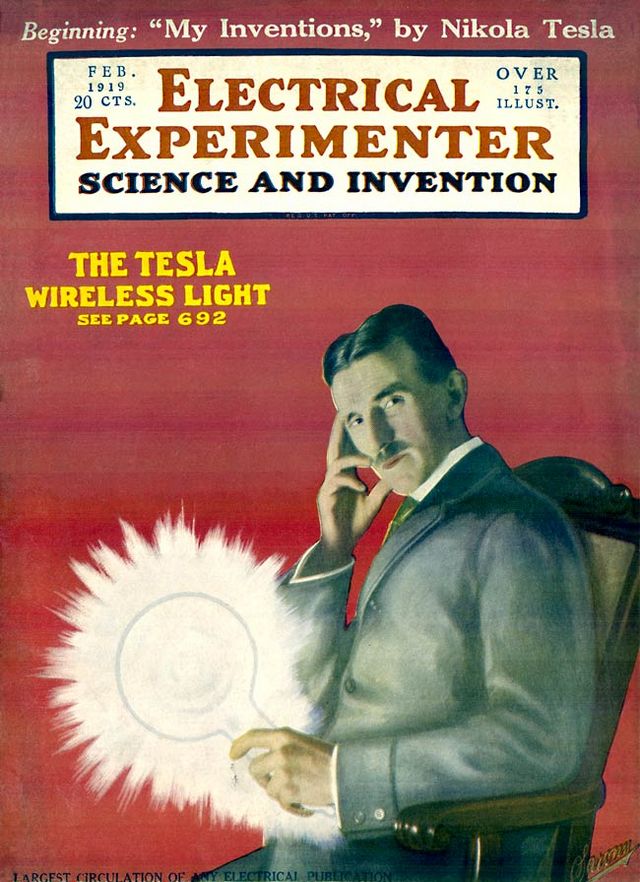
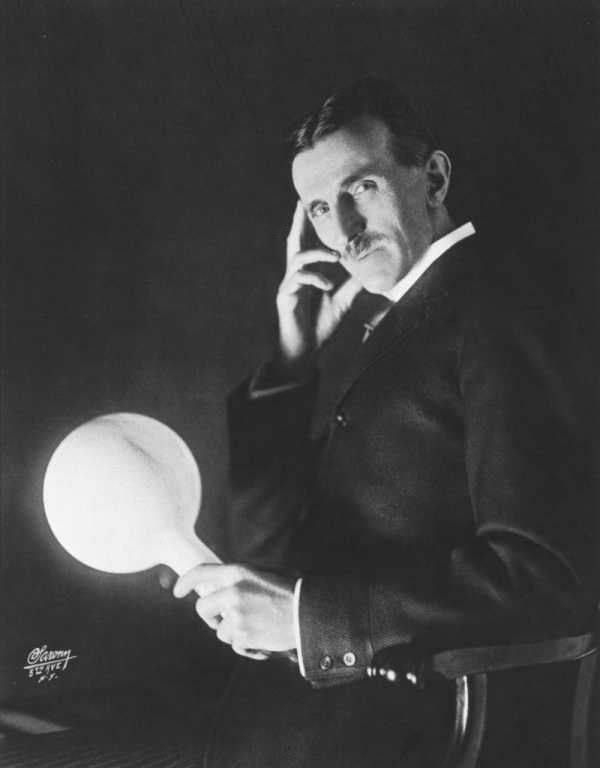
Nikola Tesla holds a fluorescent bulb wirelessly lighted due to Tesla's coil (invisible on the photo).
The coil produces high frequency alternating current of several million Hertz.
Tesla's autobiography entitled My Inventions was published as a series of six articles in Electrical Experimenter (popular-scientific monthly) during 1919, in the time when the journal was printed in one hundred thousand copies. Its editor-in-chief was Hugo Gernsback, also an inventor and considered as "The Father of Science Fiction" in the modern sense.
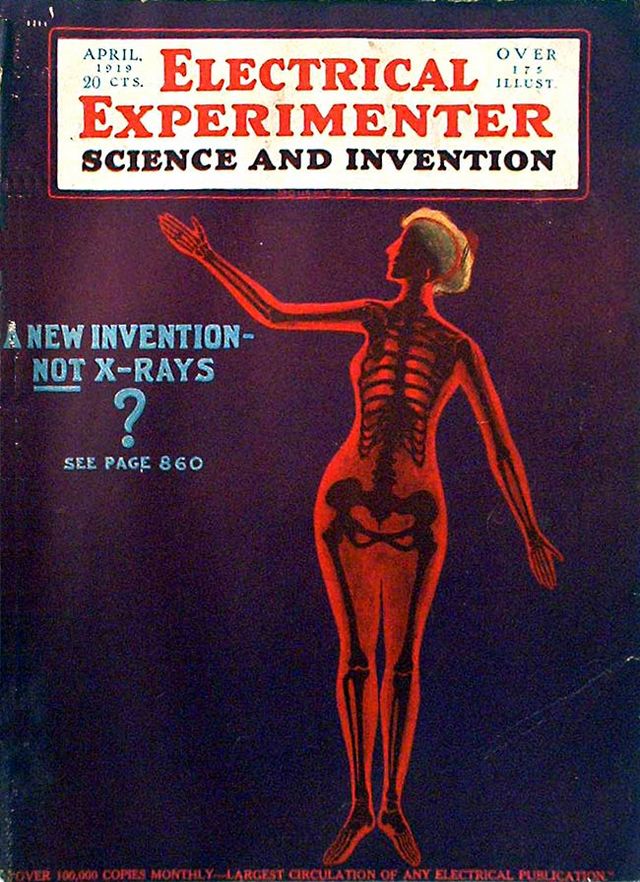
Tesla mastered English. His brilliant sentences include an occasional use of Latin, German and French expressions.
Tesla's personality showed a deep idealism and humanism, knowledge of literature, fluency in several world languages (German, French and English), as well as a deep knowledge and understanding of diverse aspects of Electrical Engineering.
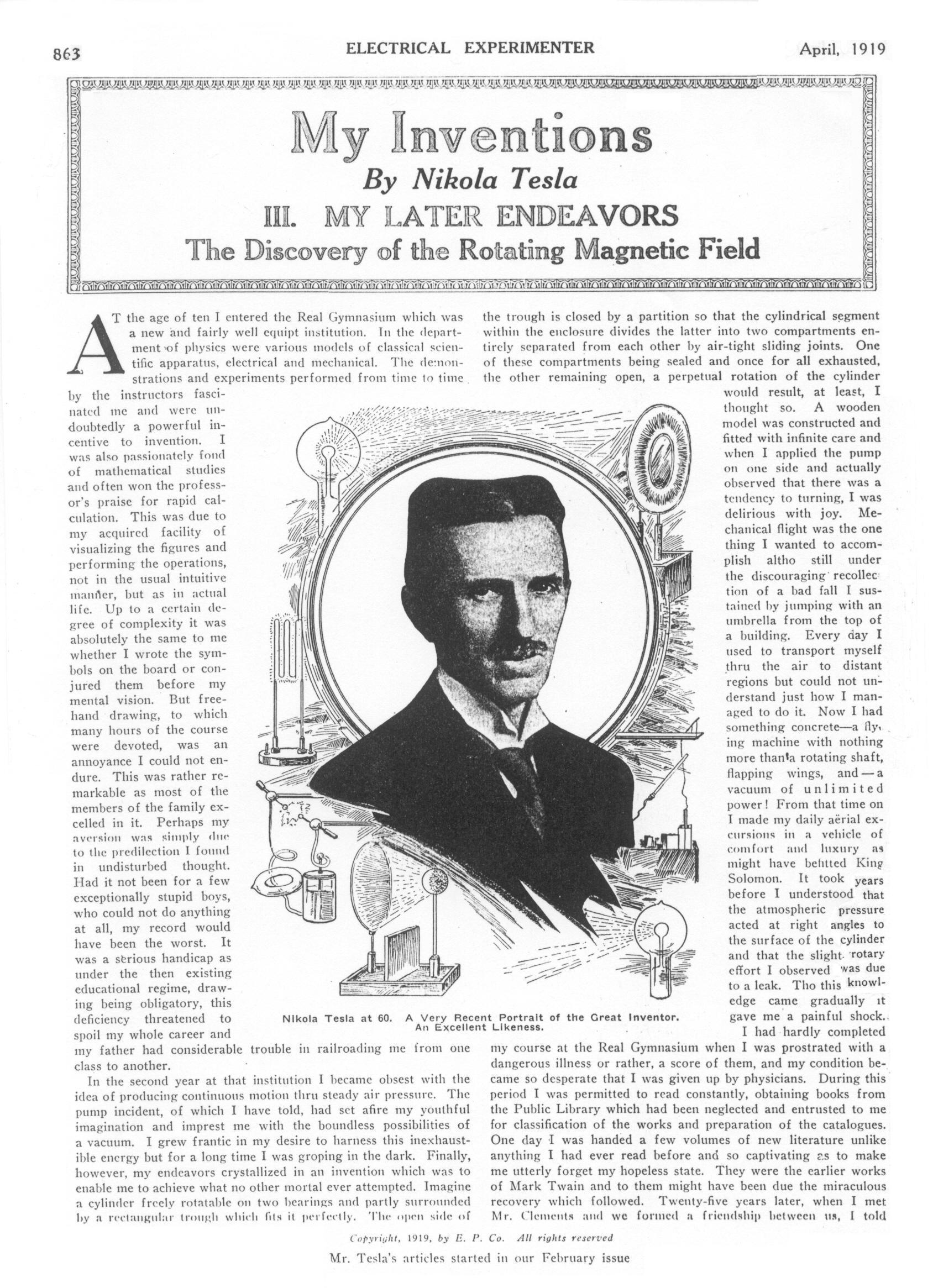
At the age of ten I entered the Real Gymnasium [Gospić] which was a new and fairly well equipt institution. In the department of physics were various models of classical scientific apparatus, electrical and mechanical. The demonstrations and experiments performed from time to time by the instructors fascinated me and were undoubtedly a powerful incentive to invention. I was also passionately fond of mathematical studies and often won the professor's praise for rapid calculations.
Electrical Experimenter
April 1919, p. 863, left column, line 1
Tesla ended the first grade (the so called "trivial school", or trivijalka in Croatian) in his native village of Smiljan. Tesla's aforesaid description should incite us to study his education in the Primary School and in the Lower Real School in Gospić, in the period of his schooling there from 1863 till 1869. He spent three school years in the Primary School and the following three years 1866-1869 in the Lower Real School. Researchers need to find out the names of his teachers, the content of various school subjects, etc. The complete German name of the Lower Real School in Gospić was Kaiserlich-königliche Unterrealschule in Gospić in der k.k. kroatischen Militärgrenze.
Tesla attended the Lower Real School in Gospić for three years. All school subjects were taught in the Croatian language, except for German, which was taught as a separate subject. See [Strohal, p. 89].
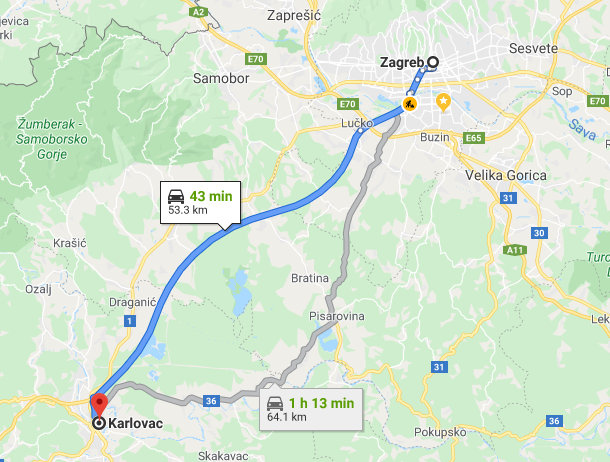 Zagreb - Karlovac: 53 km 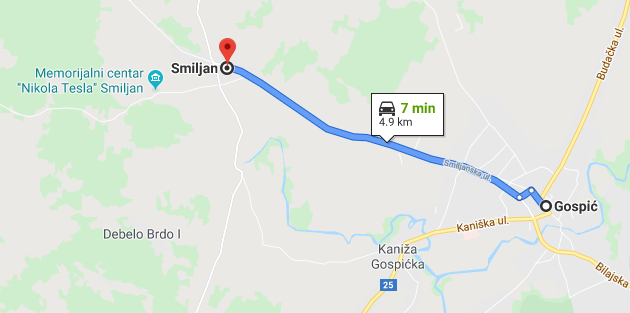 Gospić - Smiljan: 5 km |
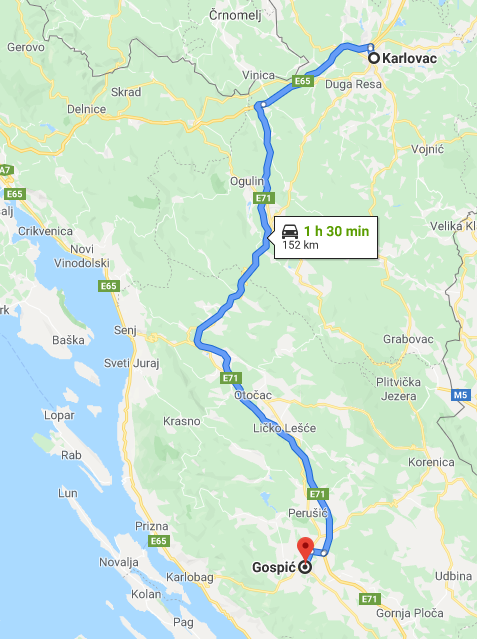 Karlovac - Gospić: 152 km |
Austro-Hungria, 1872, Ferreira da Costa, Portugal (a map of Austria-Hungary kept in the National and University Library in Zagreb, Croatia)
Schooling of Nikola Tesla in Rakovac 1870-1873
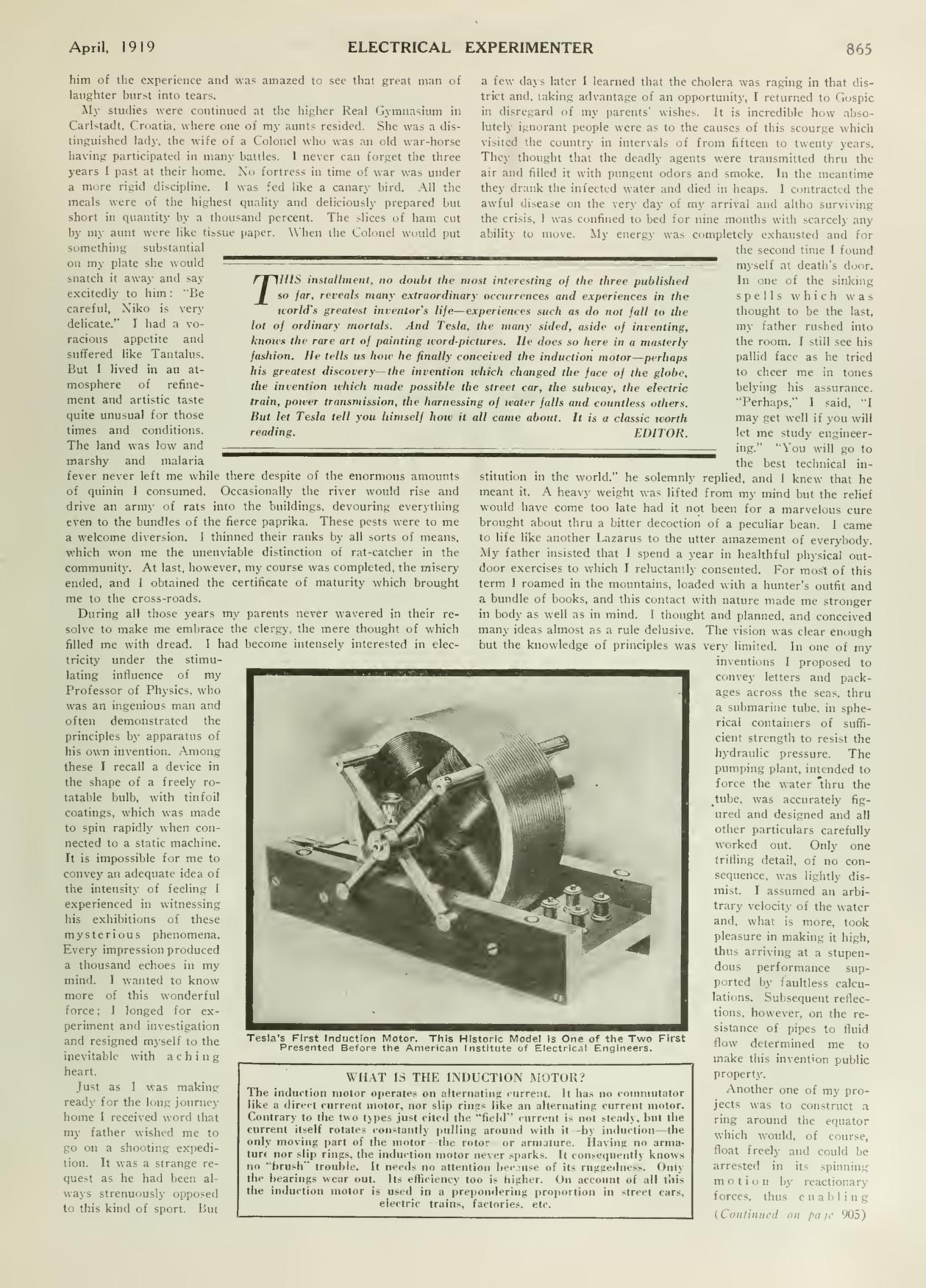

(more precisely, at the Higher Real School, and in "gymnasium school" in Rakovac, which later became a part Karlovac.) Here, gymnasium = grammar school.
At that time, Karlovac had an advanced culture and economy. In
1858, there opened the oldest Croatian singing association called Zora (i.e., Dawn, the oldest Croatian singing association). In 1867, it had as many as 60 singers.
[Strohal's
monograph gives more detailed information. It stresses (p. 104) that
the working language of the Higher Real School in Rakovac was German.
The exception was the separate school subject called "Croatian
Language". The Autumn of 1870 saw "History" and "Religion" being taught
in Croatian. Since 1874, all the school subjects had to be taught in
Croatian language, but the lack of Croatian native speaking personnel
made this impossible. Therefore, in the Autumn of 1878, the school
decided to teach Religion, Croatian language, History, and Geography in
Croatian. The other subject (i.e., the so called "real school
subjects") were taught in German. In 1883, Croatia annexed the Military
Frontier (Vojna krajina), and all the school subjects were taught in
Croatian language.
Until 1883 (i.e., until the 'unification of Military Frontier with the
motherland'), the Imperial and Royal (i.e., "K. und K.") Real School in
Rakovac was under the military command of Croatia's capital Zagreb.
After 1883, the school was under the direct control of the Royal Land
Government (i.e., Kraljevska zemaljska vlada) in Zagreb. See [Strohal, p. 104].
The expression "K. und K." (or just "K. K.", i.e., "Kaiserliche und Königliche", that is, "Imperial and Royal") refers to Austrian emperor, who was also the king of Hungary as well as of other kingdoms in Austria-Hungary, including Croatian Kingdom. Here, we should not forget that Croatia, along with Slavonia, at the time of Tesla's schooling had the status of kingdom, which was in personal union with Hungary, called Hungarian-Croatian Kingdom. The above mentioned "Royal Land Government (Kraljevska zemaljska vlada) in Zagreb" ruled Croatian Kingdom by means of one or more viceroys (called "Bans" in Croatian language; singular: "Ban"). During Tesla's schooling in Rakovac (1870-1873), there were four Croatian Bans (viceroys) in Zagreb:
- 1868 – 1871: Baron Levin Rauch de Nyék
- 1871 – 1872: Koloman pl. Bedeković de Komor (Bedeković Komorski); here pl. (plemeniti) - noble
- 1872 – 1873: Antun pl. Vukanović
- 1873 – 1880: Ivan Mažuranić.
In 1868, the Croatian–Hungarian Settlement was signed by the Hungarian Parliament and the Croatian Sabor. The Kingdom of Slavonia was incorporated into Croatia; the Kingdom of Croatia-Slavonia was established as an autonomous state within Hungary.
Since 1867, the full official title of Emperor Francis Joseph I was the following (translated from the German language):
His Imperial and Royal Apostolic Majesty,
By the Grace of God Emperor of Austria ,
King of Hungary and Bohemia, Dalmatia, Croatia, Slavonia, Galicia, Lodomeria and Illyria;
King of Jerusalem, etc.;
Archduke of Austria;
Grand Duke of Tuscany and Cracow;
Duke of Lorraine, Salzburg, Styria, Carinthia, Carniola and Bukovina;
Grand Prince of Transylvania, Margrave of Moravia;
Duke of Upper and Lower Silesia, of Modena, Parma, Piacenza and Guastalla, of Auschwitz and Zator,
of Teschen, Friaul, Ragusa and Zara;
Princely Count of Habsburg and Tyrol, of Kyburg, Gorizia and Gradisca;
Prince of Trent and Brixen;
Margrave of Upper and Lower Lusatia and in Istria;
Count of Hohenems, Feldkirch, Bregenz, Sonnenberg etc.;
Lord of Trieste, of Cattaro and on the Windic March;
Grand Voivode of the Voivodeship of Serbia
etc., etc.
In 1881, the Croatian Military Frontier was incorporated into the Kingdom of Croatia-Slavonia.
In 1883, Croatian parliamentary by-elections were organized. The first day of elections to the Sabor (Croatian Parliament in Zagreb) included the former territories of the Croatian Military Frontier. More information at the Timeline of Croatian History.
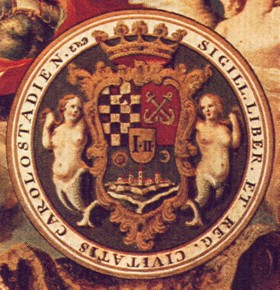
In the text below, on the left-hand side to the photo of the induction motor in Tesla's autobiography, there comes the most interesting part for us. Nikola Tesla mentions Martin Sekulić in four sentences, although he does not explicitly mention his name (similarly as in the case of his mother Georgina or Đuka elsewhere in the book).
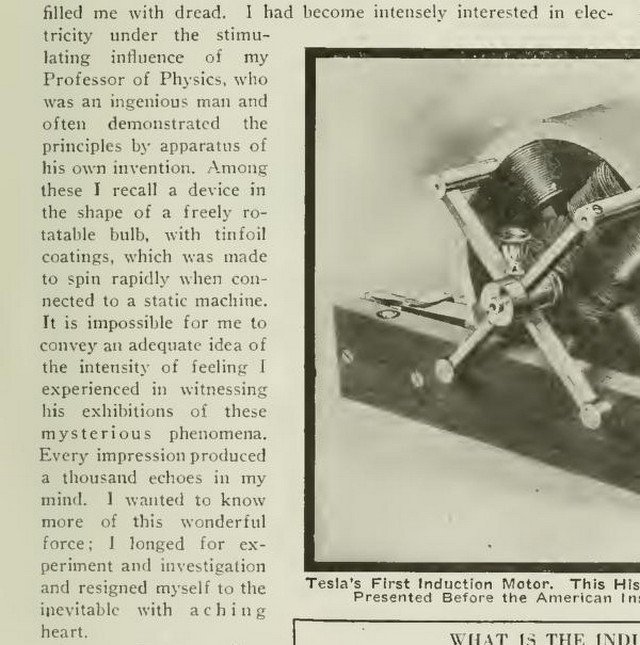
Here is Tesla's description of Martin Sekulić, his professor of Physics at the Higher Real School in Rakovac:
I had become intensely interested in electricity under the stimulating influence of my Professor of Physics, who was an ingenious man and often demonstrated the principles by apparatus of his own invention. Among these I recall a device in the shape of a freely rotatable bulb, with tinfoil coatings, which was made to spin rapidly when connected to a static machine. It is impossible for me to convey an adequate idea of the intensity of feeling I experienced in witnessing his exhibitions of these mysterious phenomena. Every impression produced a thousand echoes in my mind. I wanted to know more of this wonderful force; I longed for experiment and investigation and resigned myself to the inevitable with aching heart. Electrical Experimenter
April 1919, p. 865, left column, on the left of the photo
The name of Martin Sekulić has been almost entirely left out in the contemporary literature about Nikola Tesla, and there is hardly any book in which his name is at least mentioned. This represents a grave injustice to Nikola Tesla.
In 1882, the citizens of Karlovac decided to extend the building of the Higher Real School in Rakovac, mostly for the sake of economy, in order to unite the school with the then Gymnasium in the city of Karlovac. Hence, the so called Royal Great Gymnasium in Karlovac was founded, placed in the building of the former Higher Real School in Rakovac. This was done in 1882/83. See [Strohal, pp. 104-105]. The Higher Real School in Rakovac (intended for military profession) was closed because the Military Frontier returned to Croatia's complete sovereign administrative rule.
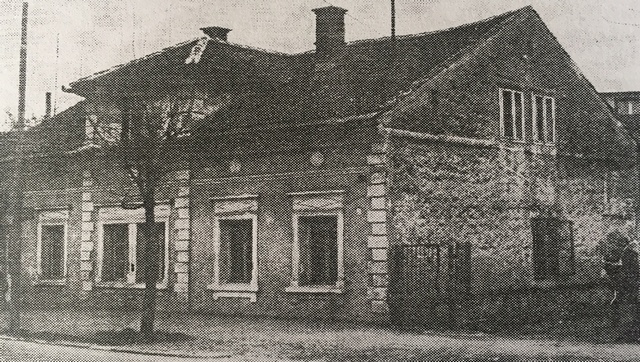
during his education at the Higher Real School. Source [Petešić].
The complete German name of the Higher Real School in Rakovac, attended by young Nikola Tesla, was Kaiserlich-königliche Ober-realschule in Rakovac in der k.k. kroatischen Militärgrenze.
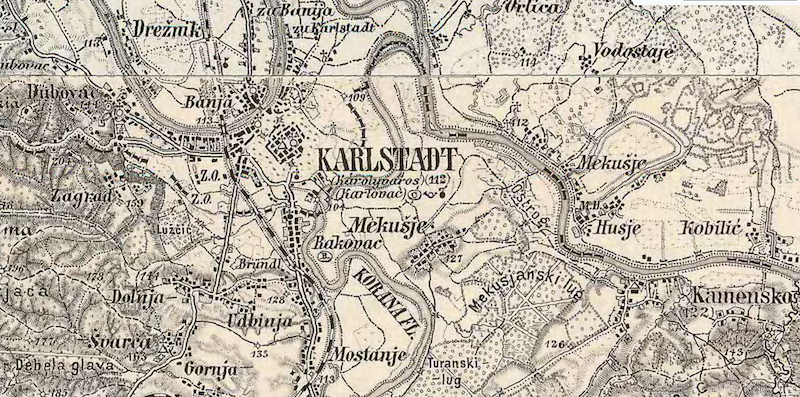
Source of the photo: [mapire.eu], Habsburg Empire (1869-1887) - Third Military Survey (1:75000).
Car i kralj Franc Jozef I, kada je donosio odredbe i zakone koje se odnose na pojedinu kraljevinu, onda se prema njoj i titulirao. Evo jedan zakonik iz 1868. g., objavljen 1870.:
MI FRANJO JOSIP PÈRVI,
po milosti božjoj car Austrijanski;
Kralj Češki i apoštolski kralj Ugarske, Hèrvatske, Slavonije i Dalmacije itd.
Martin Sekulić (1833-1905), Tesla's teacher
In the period of 1870-1873 (i.e., during of three school years: 1870/71, 71/72, and 72/73) Tesla was educated in the town of Rakovac from his 14th to 17th years. Rakovac is today a part of the city of Karlovac.
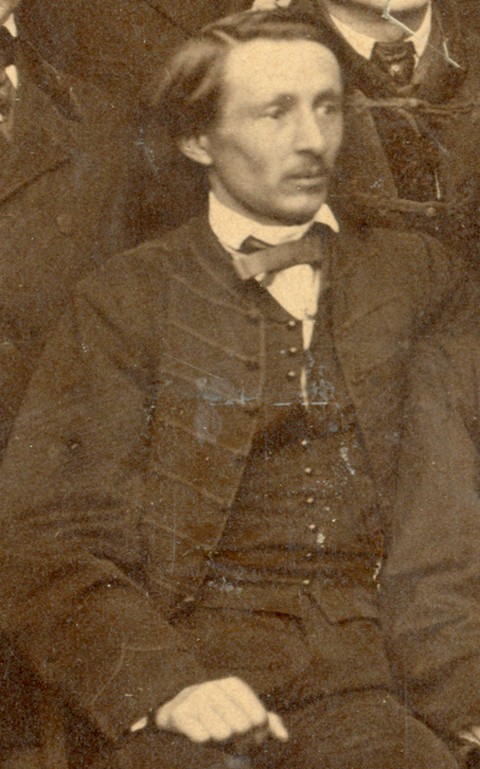
Martin Sekulić directed a physical laboratory in the Higher Real School in Rakovac, which was equipped with of as many as 579 instruments!
(see Statistika nastave u kraljevini Hrvatskoj i Slavoniji i hrvatsko-slavonskoj Vojnoj krajini školske godine 1871-72., Zagreb 1873.)
Among his basic school subjects in Rakovac, Tesla had Croatian Language (Kroatische Sprache) as his mother tongue.
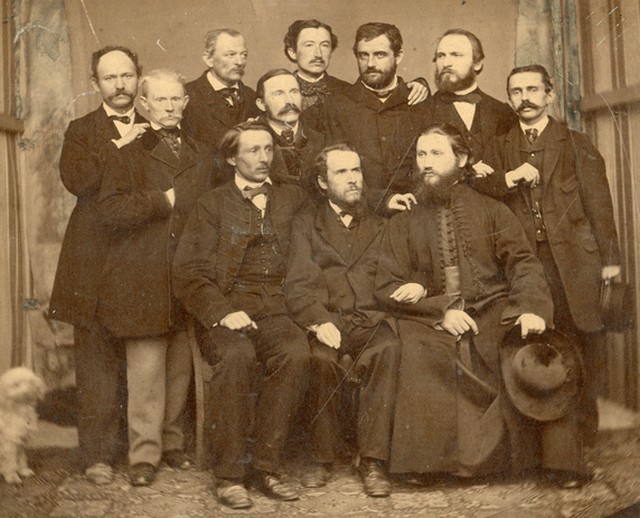
As we can see on the photo of Martin Sekulić and his colleagues in the Rakovac Higher Real School (kept in the Croatian School Museum in Zagreb), the professors were dressed in nice uniforms. The students also wore the uniforms, but we do not know how they looked like.
The Higher Real School served to educate students for military profession in Croatian-Slavonian Military Frontier (Hrvatsko-slavonska vojna krajina). The occupied parts of Croatian territories (roughly, western part of today's Bosnia and Herzegovina between rivers Una and Vrbas) became known as Turkish Croatia. Indeed, on various European maps from that time (18th-19th centuries), we encounter the names od Türkisch Kroatien (in German), Croatie Turc (in French), Croazia Turca (in Italian), as well as Turska Hrvatska (in Croatian).
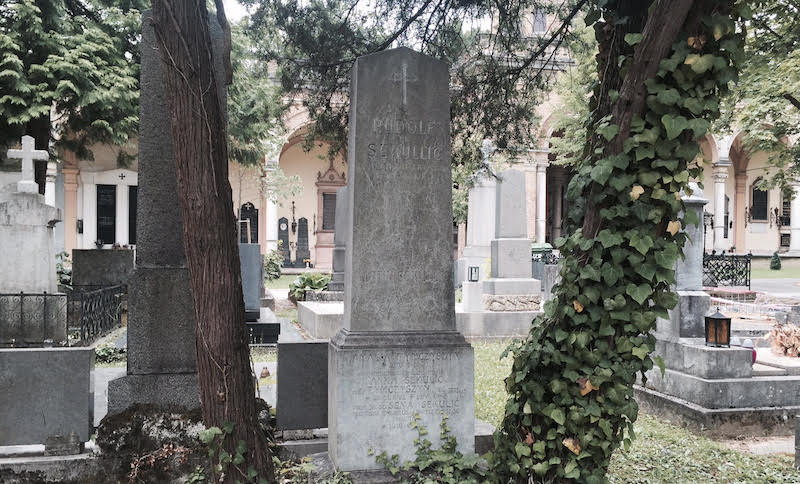
in front of the Arcades. Mirogoj is one of the most beautiful cemeteries in Europe.

As Nikola Tesla, Martin Sekulić (1833-1905) was also born in the Croatian region of Lika, in the town of Lovinac. Martin Sekulić has noble roots: he is descendent of the city of Senj nobility. On his grave in the Mirogoj Cemetery we can read MARTIN SEKULLIĆ, carved with the double L.
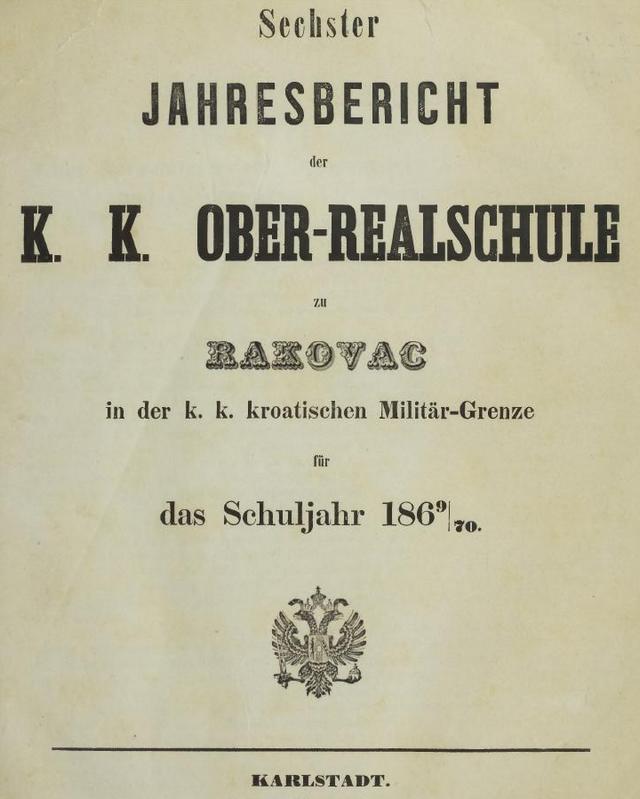
Jahresbericht K. K. Ober-Realschule zu Rakovac in der k. k. kroatischen Militär-Grenze für das Schuljahr 1869./70.
(Yearbook of the Imperial and Royal Higher Real School in Rakovac in Croatian Military Frontier,
for the school year 1869/70)

in der k. k. kroatischen Militär-Grenze
(i.e., Rakovac in the Imperial and Royal Croatian Military Frontier - Hrvatska vojna krajina)
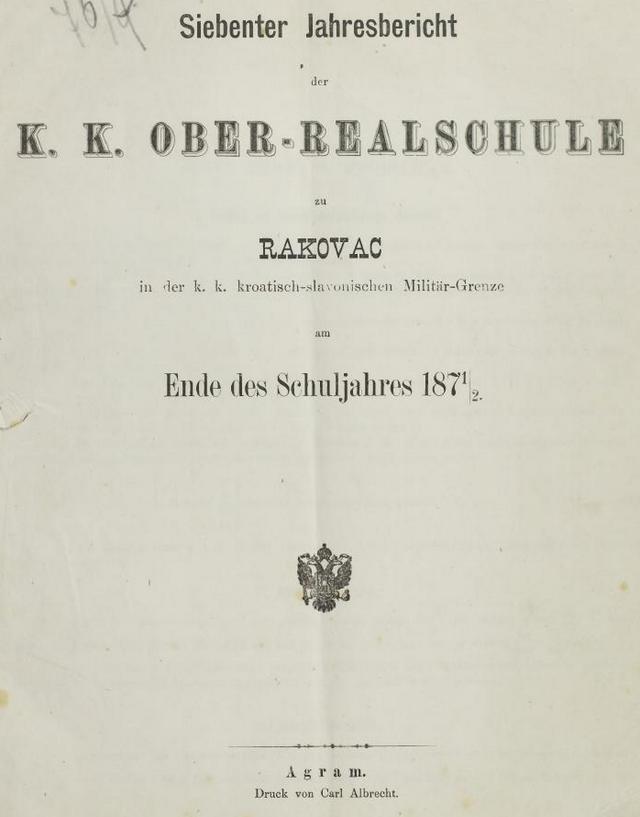

The Military Frontier (Vojna granica) is oficially called Croatian Military Frontier or Croatian-Slavonian Military Frontier (Hrvatsko-slavonska vojna krajina).

It was published in 1874 in Zagreb.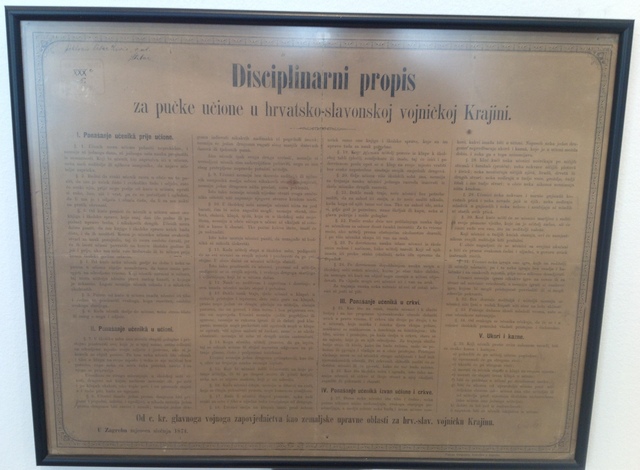
Some of the disciplinary regulations during Tesla's education in Croatia were:
11. Kada učitelj stupi u školsku sobu, podignuti će se svi učenici sa svojih mjesta... (When a teacher enters a class, all students will raise)
12. Nauk se molitvom i započima i dovršuje (Each lesson starts and ends with prayer)
22. Poslie svake dvie ure poldašnjega nauka daje se učenikom odmor deset časaka (minuta)... (After every two hours of daily teaching, students are given 10 minutes of rest)
In 1873, Tesla completed his secondary schooling with matriculating in front of the committee consisting of eleven (sic!) professors. Due to the existence of such a serious exam, he did not have to enter the admission exams in any of the high technical schools in Austro-Hungarian Empire. Thus, he enrolled directly at the prestigious High Technical School in Graz, Austria. Most probably, there Tesla met Antun Lučić - Anthony F. Lucas, the future Father of Petroleum Engineering (Tesla's compatriot, born in 1855 in the city Split, one year before Nikola Tesla).
What Nikola Tesla represents for Electrical Engineering in general, Antun Lučić (Anthony F. Lucas) represents for Petroleum Engineering. Every year, since 1936 till these days, the American Geological Society awards the prestigious Lucas Medal.It is little known that the last Turkish Osmanly (Ottoman) attack on the city of Karlovac, attempting its occupation, took place in 1878, i.e., only five years after Tesla's completion of his schooling in Rakovac. (this information is given by the courtesy of Antun Milinković, professor at the Gymnasium of Karlovac, working in the same building in which Nikola Tesla attended the then Higher Real School. That same year, Austro-Hungary annected Bosnia and Herzegovina, on the basis of the decision of the Berlin Congress.
Martin Sekulić - corresponding member of JAZU (today HAZU - Croatian Academy) in Zagreb
In 1873, at the age of 40, Martin Sekulić became a corresponding member of the Academy in Zagreb, at the Department of Mathematics and Natural Sciences. In that year, Tesla was completing his schooling in Rakovac, where Martin Sekulić was his professor.
Martin Sekulić has published 13 papers (three of them in prestigious Annalen der Physik, one in Wiener Any. Jahrg, and nine papers in Rad JAZU, a journal of the Academy which exists also today); see [Vuković and Valent].
Let us list the titles of some of the papers of Martin Sekulić (the source of information is mainly the German Wikipedia and [Muljević]):- Beziehungen zwischen der elektromotorischen Kraft und der chemischen Wärmetönung
- Ultraviolette Strahlen sind unmittelbar sichtbar; In Chemisches Central-Blatt, Band 43, 1872
- Eine merkwürdige Interferenzerscheinung; Pogg. Ann. (tj. Poggendorffs Annalen), CXLIX, 126. 1873
- Fizika atoma i molekula (Physics of the atoms and molecules), Rad JAZU, Knj. 26(1874) str. 109-152.
- Ueber die an bestäubten und unreinen Spiegeln sichtbare Interferenzerscheinung; In: Annalen der Physik; Volume 230, Issue 2, S. 308–316, 1875, doi:10.1002/andp.18752300212.
- Uzrok munjotorskoj sili (The source of electrical force), Rad JAZU, br. 41 (1877), br. 50 (1879), br. 58 (1881)
- O ledenoj dobi sjeverne polutke naše zemlje (On the Ice Age in the northern hemisphere), JAZU 64 (1882)
Young Nikola Tesla had the opportunity to witness among others Sekulić's experiments with artificial polar light. On one occasion, Martin Sekulić informed the Academy in Zagreb that he managed to directly detect ultraviolet rays, about which he published one paper (the above mentioned "Eine merkwürdige Interferenzerscheinung"; Pogg. Ann., 1873.). After that, Sekulić was contacted by Mr. Lettson from the "Royal Institution of Great Britain", asking him for additional information about his experiments. See [Muljević, p. 333].
All these insights were important to then young Nikola Tesla in his subsequent work in the USA, dealing with fluorescent (and later neon) bulbs.
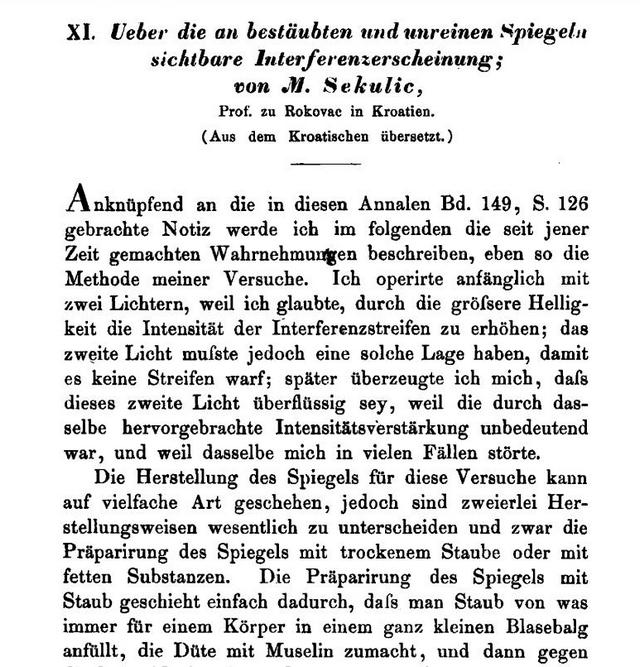
An article by Martin Sekulić published in prestigious German scientific journal Annalen der Physik in 1875.
Here we can see a part of the first page (p. 308); the whole first page: [JPG].
Instead of Rakovac, there is a small mistake in the title: Rokovac.
Below his name, it is stressed that he is a professor in Rakovac in Croatia,
and that the paper represents a translation from Croatian language.
The entire Sekulić's work is available (upon paying) at doi:10.1002/andp.18752300212.
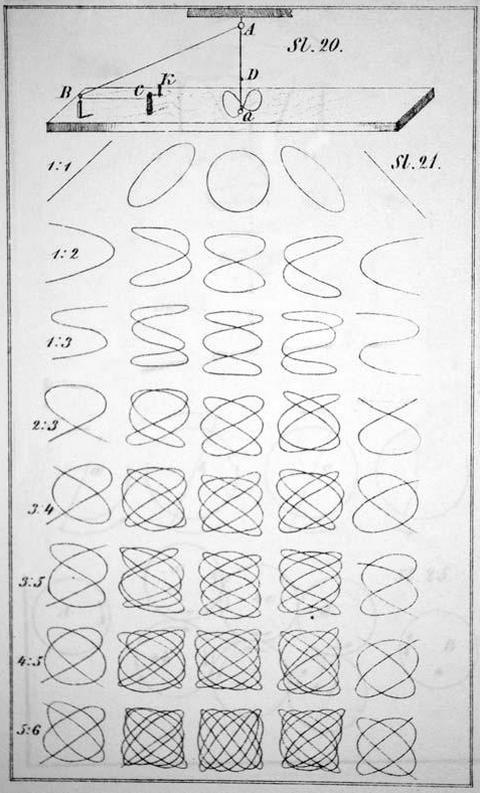
Lissajous curves that Martin Sekulić drew and described in his paper
Fizika atoma i molekula (The physics of the atoms and molecules), Rad JAZU Knj. 26(1874) pp. 109-152.
Sekulić constructed a special apparatus for drawing Lissajous curves. See [Muljević, p. 334].
Tesla became a honorary member of the Academy (JAZU, now HAZU) in Zagreb in 1896, also at the age of 40 as Sekulić. The Academy (JAZU) in Zagreb was founded in 1866. Martin Sekulić became its member seven years after its founding, while Nikola Tesla was elected thirty years after its founding.
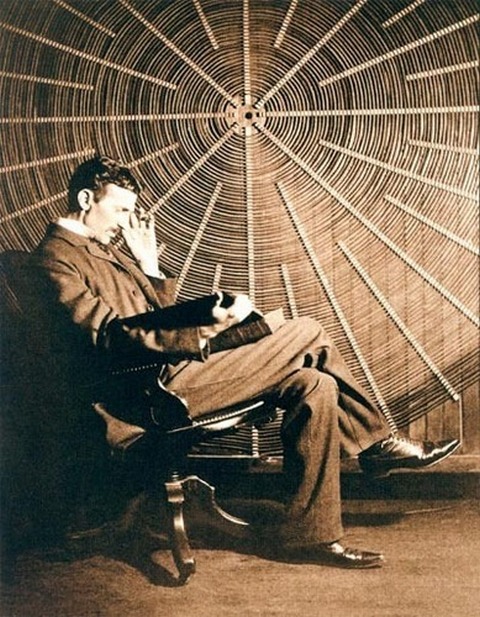
It is often erroneously claimed that Tesla is with the book of of Ruđer Bošković, Theory of Natural Philosophy,
published in 1758 in Vienna. Tesla was in possession of that book as well.
Sekulić enthused Tesla for Bošković, by popularizing Bošković's idea that the whole Physics can be founded on the unique type of force.
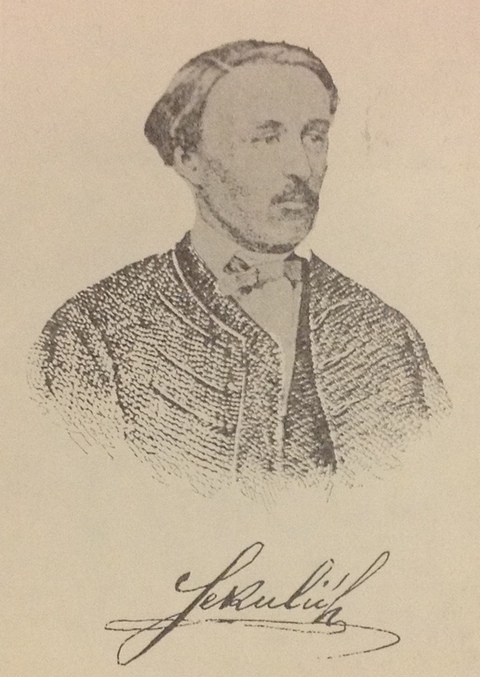
(on the slopes of the South Velebit hinterland near the coast),
professor of Mathematics and Physics, who enthused young Nikola Tesla for electricity.
The prestigious journal Annalen der Physik was founded already in 1790 (in the time of the beginnings of Sekulić's scientific work, the complete name of the journal was Annalen der Physik und Chemie). Martin Sekulić published three of his papers in this journal in 1872, 1873, and in 1875, in German language. This shows that young Nikola Tesla listened to the lectures of Martin Sekulić at the time of his greatest scientific activities.
Since 1895, German Nobel Prize winner Max Planck served as an associated editor of Annalen der Physik, while from 1907 till 1943, he was its editor in chief.
We mention in passing that in 1942, at the age of 84, Max Plack delivered an invited lecture at the University of Zagreb. He was welcomed by Stjepan Ivšić, distinguished Croatian linguist and the then Rector of the University. The lecture was conducted in the stuffed lecture hall of the then Technical Faculty (of the University of Zagreb) in Kačićeva street 26, entitled "The meaning and bounds of exact natural sciences." No photo of Planck's sojourn in Zagreb has been preserved. Even the Hotel Esplanade in Zagreb, where Planck stayed, has no preserved information about the sojourn of distinguished scientist (all the documents were destroyed after 1945, during the communist time in ex-Yugoslavia).
During his lecture in Zagreb, Planck spoke among others about the danger of the atomic bomb (which was for the first time unveiled for the broad public). See [Leo Randić].
Other Tesla's professors in Rakovac

in the time when young Nikola Tesla attended it. Source [Cuvaj, str. 215].
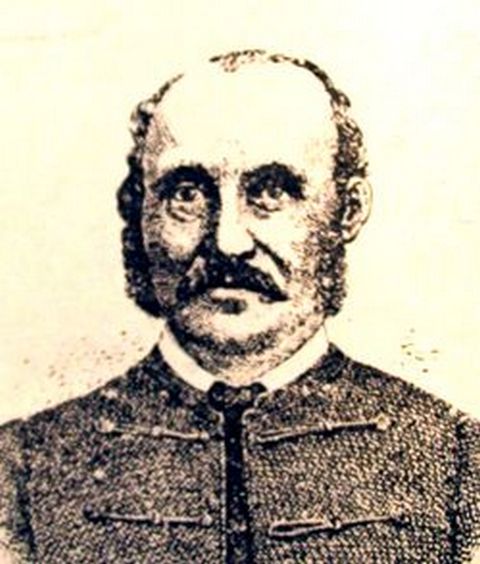
a member of the matriculation committee to young Nikola Tesla, responsible for schools in the entire
Croatian-Slavonian Military Frontier (Hrvatsko-Slavonska vojna krajina). The exam was conducted in German.
One of the members of the matriculation exam committee for young Nikola Tesla at the Higher Real School in Rakovac was professor Živko Vukasović (1829-1874), zoologist, entomologist and a full member of JAZU, the then Academy in Zagreb (besides this, he was one of two school overseers for the whole of Croatian-Slavonian Military Frontier - Vojna krajina). Born in the village of Beravci (south of Đakovo), he completed two very different studies at the universities of Vienna and Graz: Law and Biology.
In 1873, Tesla matriculated in the group of seven students, examined by the committee consisting of as many as eleven professors:
Šoštarić, Franjo Kreminger, keeper of the minutes,
M. Sekulić, A. Hoeffler, N. Gr. Živković, Petar Tomić, G. Fridrih, Jagunić, M. Brašnić, Joh. Jamnicki.
Dr. Petar Tomić (1839.-1918.), born in the town of Zabok in Hrvatsko Zagorje (region on the north of Zagreb), professor of History and Geography, was also a member of the matriculation committee. The next year (i.e., in 1874) he earned his PhD in Graz.
Nikola Tesla matriculated on July 24th, 1873. In his matriculation form (written in German; see the photo below) Tesla is mentioned as seventh in order, and his birth date is mistakenly written as November 2nd, 1856 (should be 9/10 July)
- ISPITANIKOVO IME (name of the examinee): Nikola Tesla
- VJERA (faith): grčke nesjedinjene (Greek non-united)
- RODNO MJESTO (birthplace): Smiljan u Vojnoj krajini (Smiljan in Military Frontier)
- DOMOVINA (homeland): Hrvatska (Croatia)
- STAROST (age): rodj. (born on) 2. novembra 1856. god. (should be July 9/10, 1856)
- ZANIMANJE RODITELJA (occupation of parents): Sin grčkonesjedinjenog protojereja Milutina Tesle (son of Greek non-united archpriest Milutin Tesla)
- STUDIJ GIMNAZIJE (study at gymnasium school): Učio malu realku u Gospiću, a veliku realku svršio u Karlovcu (attended Lower Real School in Gospić, and Higher Real School in Karlovac)
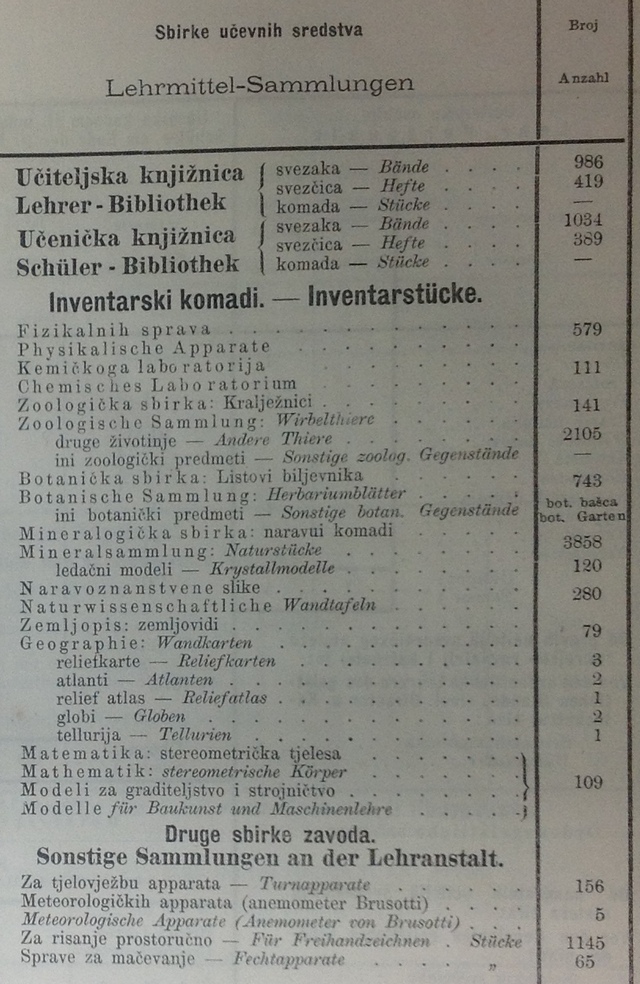
Statistics of teaching from 1871. (i.e., from the year when young Nikola Tesla was a student at the Rakovac Higher Real School, at the age of 15) inform us that
the Physics cabinet in the Rakovac Higher Real School possesses as many as 579 (five hundred and seventy-nine) instruments! This cabinet, as we have already mentioned, was directed by professor Martin Sekulić.
(The source of this important information is: Statistika nastave u kraljevini Hrvatskoj i Slavoniji i hrvatsko-slavonskoj Vojnoj krajini školske godine 1871-72., Zagreb 1873. / Statistics of Teaching in the Kingdom of Croatia and Slavonia and in Croatian-Slavonian Military Frontier in the School Year 1871-1872)
All this shows us that young Nikola Tesla had excellent professors, and that his school in Rakovac was enviably equipped with teaching tools, especially in the field of Physics (including Electrical Engineering).
Nikola Tesla and Croatian language
In 1868, a decision was taken that the Croatian language should be equal to German in all gymnasiums and real schools on the territory of Croatian-Slavonian Military Frontier. It was not possible to carry out this decision in the Lower Real School in Gospić (where Tesla completed his first three years of education), "because only two teachers know Croatian language" (namely, in the aforementioned school the majority of teachers were foreigners, who were lecturing in German). The Gospić Lower Real School added the fourth grade only in 1872. See [Petešić, p. 28]. For the same reason, it was only in 1874 that the Higher Real School in Rakovac passed to the teaching in Croatian language. Until then, there was a special subject called Kroatische Sprache (Croatian Language), which was listened to by young Nikola Tesla.
In 1871 (when Tesla was at the age of 15), the Higher Real School in Rakovac added the seventh grade, by interpolating an additional grade between three lower and three higher grades. For this reason, Nikola Tesla skipped the fifth grade, and jumped from the fourth grade immediately to the sixth grade.
All the school subjects appearing in the Yearbook of the Imperial and Royal Higher Real School in Rakovac (Godišnje izvješće Carske i kraljevske velike realke
u Rakovcu) for the period of 1872-1874, are described not only in German, but also in Croatian language.
Let us see the content of the subject Croatian Language in Tesla's school in Rakovac (three hours weekly):

The description of this school subject is provided parallelly in German (see above) and Croatian (see below) languages.

Let us see the school subject called prirodoslovje (i.e., Physics; four school hours weekly):

The description of this school subject is provided parallelly in German (see above) and Croatian (see below) languages.
Physics. Heat, electricity and magnetism. Static of solids and liquids based on experiments and on popular mathematics.
Let us also see mathematika, i.e., Mathematics (five school hours weekly):

The description of this school subject is provided parallelly in German (see above) and Croatian (see below) languages.
In time when Nikola Tesla was a secondary school student at the
Higher Real School in Rakovac (at the age of 14-17), there was an
elective school subject called pjevanje (gesang), i.e. Singing:

The above information about singing can be found in the Yearbook (Godišnje izvješće) published in Zagreb (Agram) in 1871/1872.
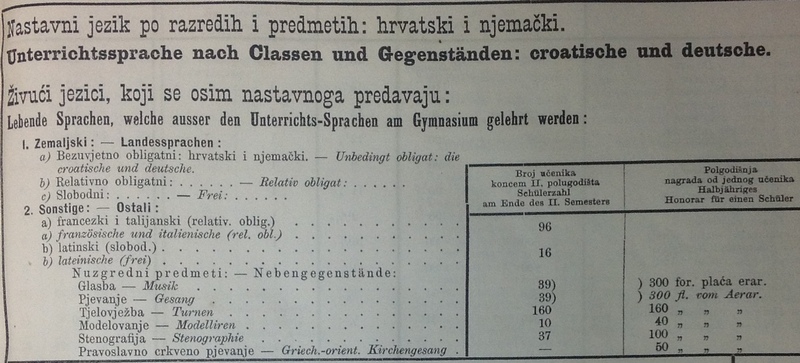
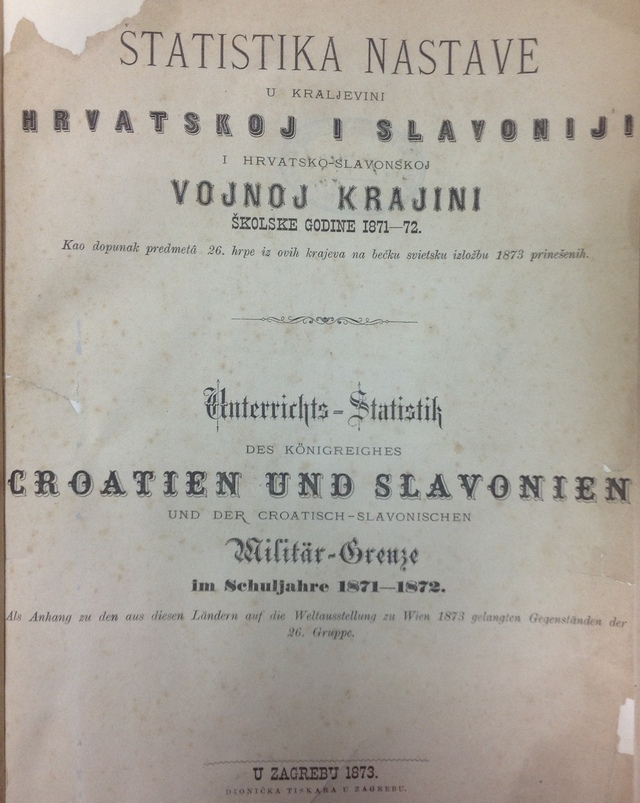
Tesla's diplomas and documents from Rakovac
Tesla's mother tongue during his schooling was Croatian:
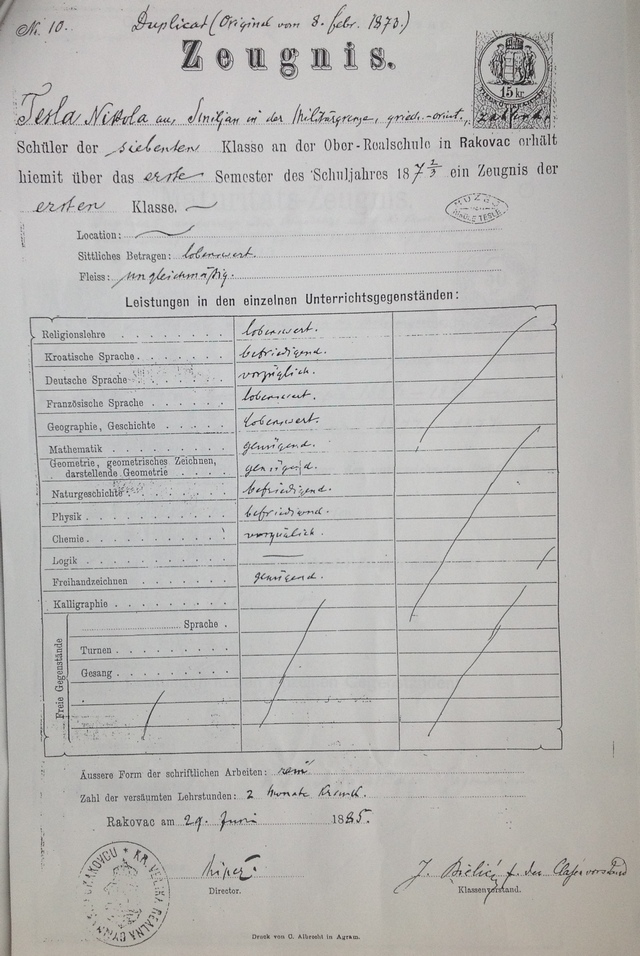
form the first semester of the school year 1872/73.
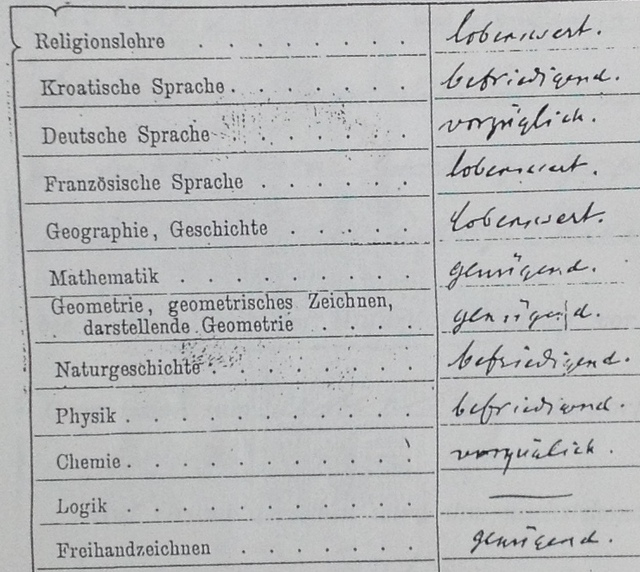
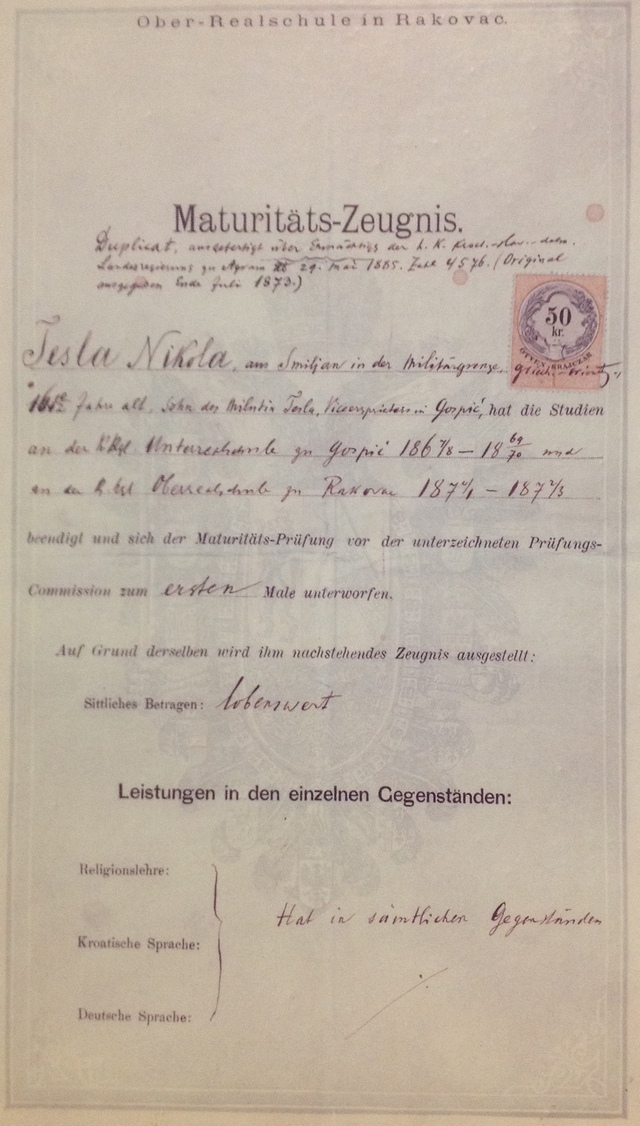

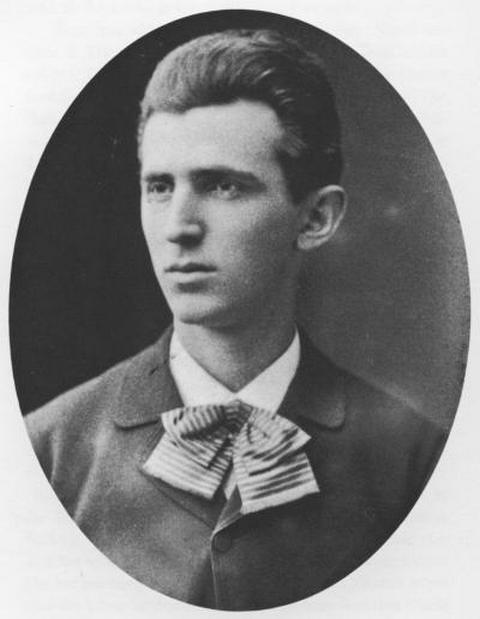
On Schooling of Nikola Tesla in Rakovac Tesla arrived in Karlovac in the Autumn of 1870, in order to inscribe to the Higher Real School in Rakovac. The town of Rakovac belonged to the Croatian-Slavonian Military Frontier, in which the teaching was conducted in German. The school subjects had the following six marks:
Tesla asked for duplicates since he needed them as a supplement to his request, asking for the USA citizenship, which he has obtained in 1891. The Lower Real School in Rakovac was founded in 1851. In 1863, it was extended as a Higher Real School, and in 1871 the additional seventh grade was introduced. Since 1878, some of the school subjects were taught in Croatian (namely, Croatian language, Physics, Geography, Religious teaching), while other subjects ("real" subjects) were taught in German. It was so until the [1883] inclusion of the Military Frontier to the Banic Croatia (Banska Hrvatska, where Ban of Croatia = Governer of Croatia). Source Dušan Pejnović: O školovanju Nikole Tesle u Rakovcu (source [JPG]), Matematičko-fizički list, Zagreb, br. 3, 1956-57, p. 112 Dušan Pejnović (1883-1958) was Croatian physicist, the author of about 160 papers (information by Branko Hanžek, PhD), and a collaborator of Croatian Encyclopedia. |
In the fourth grade of the Higher Real School in Rakovac, Tesla had an excellent mark in Croatian Language; see [Jadrić, Mihaljević].
The reason for his lower marks at the matriculation exam could be his interest in chess. Namely, in 1873, he became the chess champion among secondary school students in the city of Karlovac. Information about this is provided by Zdravko Švegar in his book Izidor Gross i šah u Karlovcu (Isidor Gross and Chess in Karlovac), 1999., by citing Teslin životopis (Tesla's Autobiography) written by Slavko Bokšan (see the following source: Nikola Tesla i šah, i.e., Nikola Tesla and chess). In his autobiography, Tesla does not say anything about this success, since he probably did not attach a great importance to it.
Passport issued to Nikola Tesla in Croatia's capital Zagreb in 1883
In 1883, the presidency of the royal Croatian-Slavonian-Dalmatian land government in Zagreb, issued Tesla's passport to the regional office in Gospić "for abroad - France, Russia and Germany, for three years"; see [Petešić, p. 47].
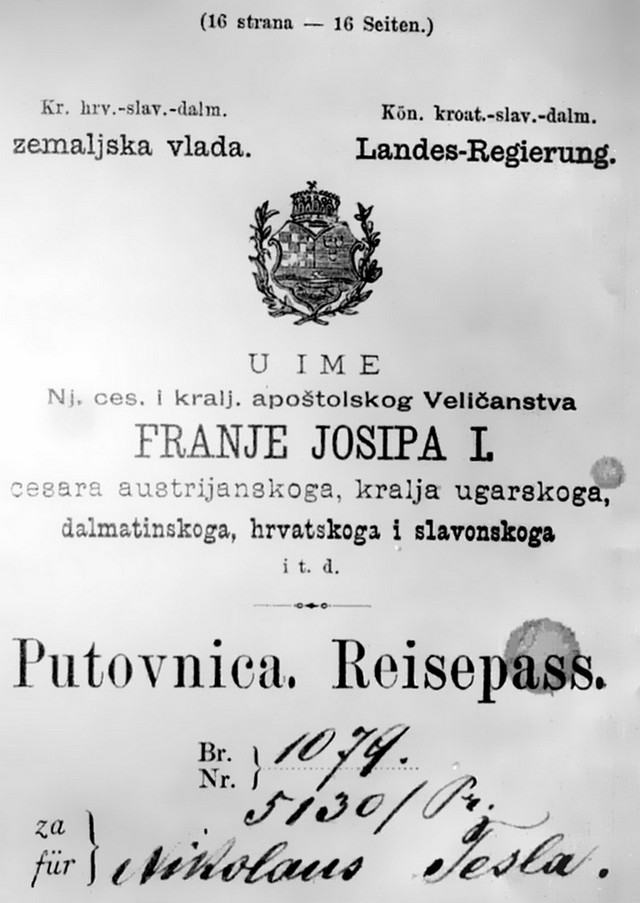
In the middle, there is the Coat of Arms of the Kingdom of Croatia-Slavonia-Dalmatia.
Franz Joseph I is entitled as the Emperor of Austria, King of Hungary,
Dalmatia, Croatia and Slavonia,
etc.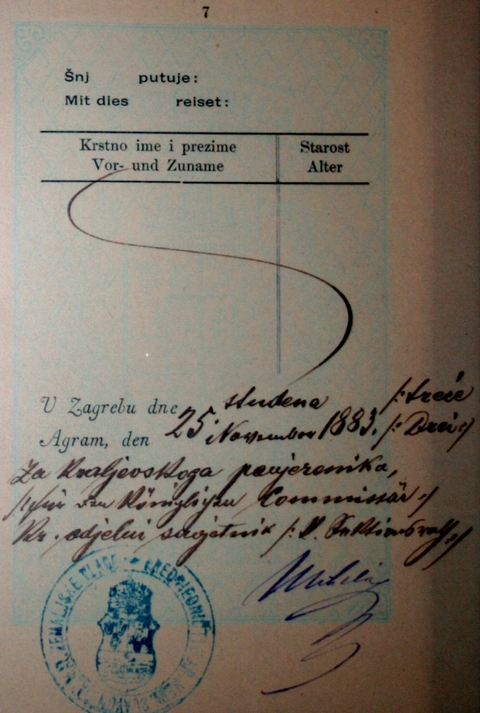
when Nikola Tesla was at the age of 27.
The library of the Gymnasium (grammar school) in the city of Karlovac possesses documents on issuing Tesla's documents in the time when he was already in the USA. More precisely, Tesla's uncle, the Gospić archpriest Petar Mandić, submitted a request to the Royal Land Government (of the Three-Une Kingdom of Croatia, Slavonia and Dalmatia), to the Department of Religious matters and Education, in order to "issue a matriculation form for Nikola Tesla to me". The uncle wrote that Tesla "has left for New York in America, in order to be trained in telephone profession, and for this he needs his matriculation form for studies that he has completed here." The request was resolved in the positive on July 1st, 1885 (no. 4576). See [Petešić, p. 54].
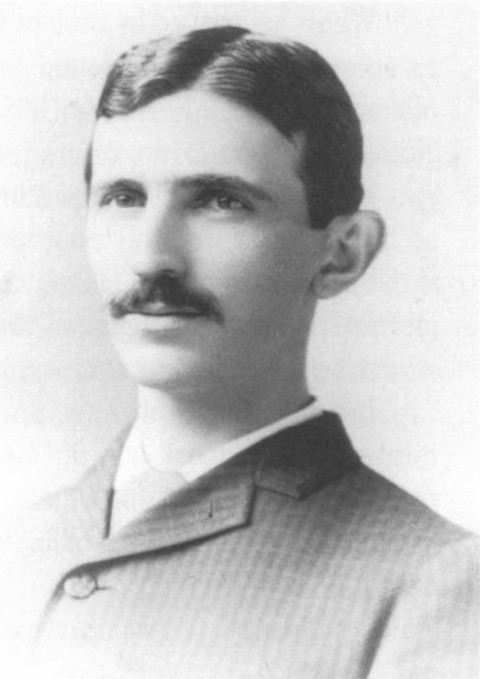
Ćiril Petešić considers it to be unclear how was it possible that Tesla could travel without any passport from Budapest to France and Germany in 1882. Also, it is not known how Tesla obtained permission to travel to the USA in 1884, since this destination was not predicted in his passport issued in Zagreb in 1883. See [Petešić, p. 47].
Humanism in the time of Tesla's schooling in Rakovac
At the Higher Real School in Rakovac, attended by Nikola Tesla, there was the Society for Supporting Poor Students (Družtvo za podporu siromašnih učenika), founded already in 1860.
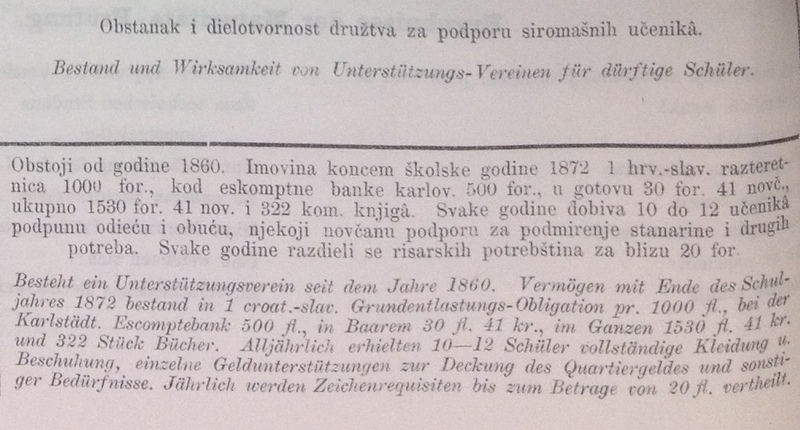
Society for Support for Poor Students, founded already in 1860 (p. 60).
Source: Statistics
for the Schooling in the Kingdom of Croatia and Slavonia and in
Croatian-Slavonian Military Frontier in the school year 1871-72 (Statistika nastave u kraljevini Hrvatskoj i Slavoniji
i hrvatsko-slavonskoj Vojnoj krajini školske godine 1871-72.), Zagreb 1873.
His ideal and all his efforts were directed towards the advancement of Mankind. After that, he turned to mysticism and recounted to me, that he was since his youth praying to God before going to sleep, kneeling on bare knees. When I asked him, which prayers does he pray, he answered to me:
- Those, that I prayed since my childhood. But, yes, I prayed so until my fifties. Since then, I pray differently, but the essence is the same, and I pray to God every day.
Ivan Meštrović: Uspomene na političke ljude i dogadjaje (Reminiscences of Political People and Events), Buenos Aires, 1961., Knjižnica Hrvatske revije. (pp. 191-193); or Matica hrvatska, Zagreb 1969 (pp. 169-170)
Differences between two versions of Tesla's autobiography
Lecture of Nikola Tesla in the City Hall in Zagreb in 1892
How does the interior of the City Hall on the Upper Town in Zagreb look like, where Nikola Tesla delivered his invited lecture? Croatian Coats of Arms can be seen on the walls and on the ceiling:
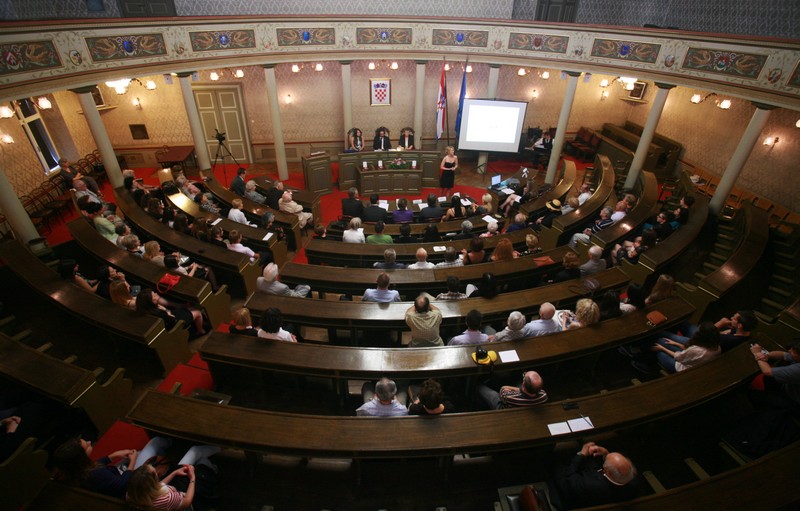
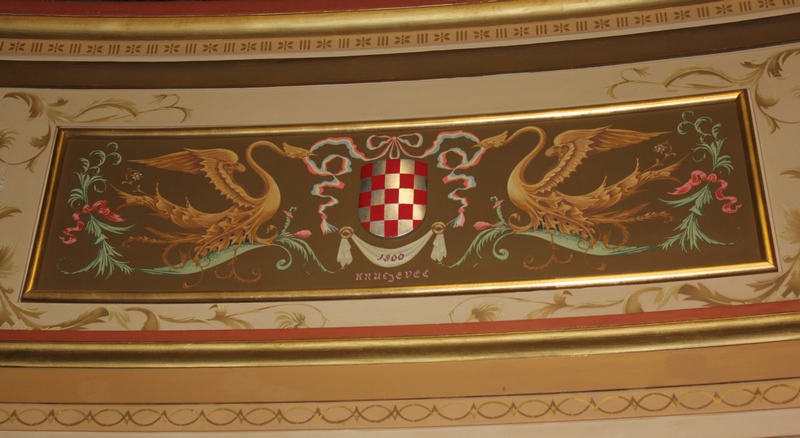
to the capital of his homeland in 1892.
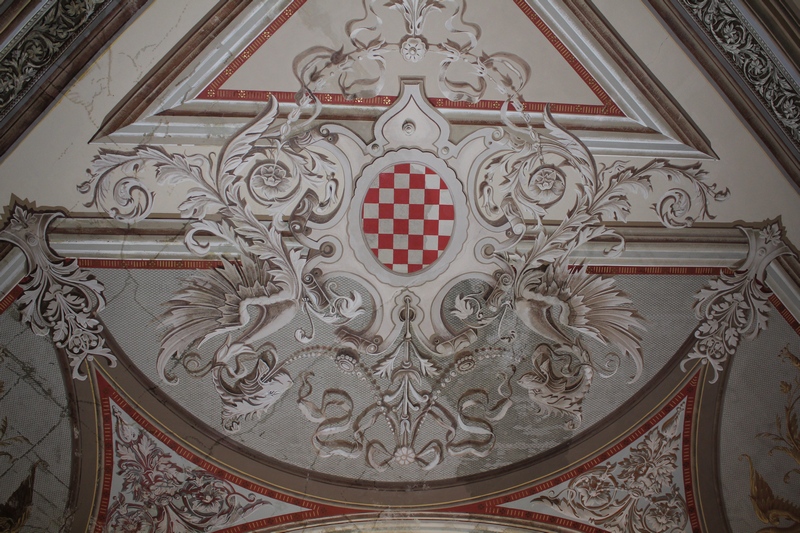
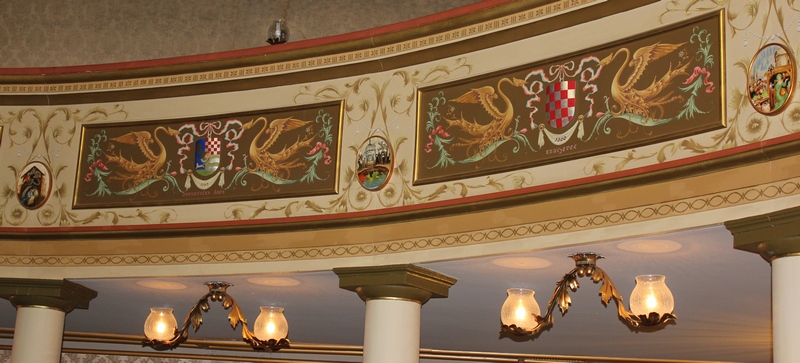

An article about the lecture by Nikola Tesla delivered in the Zagreb City Hall in 1892.
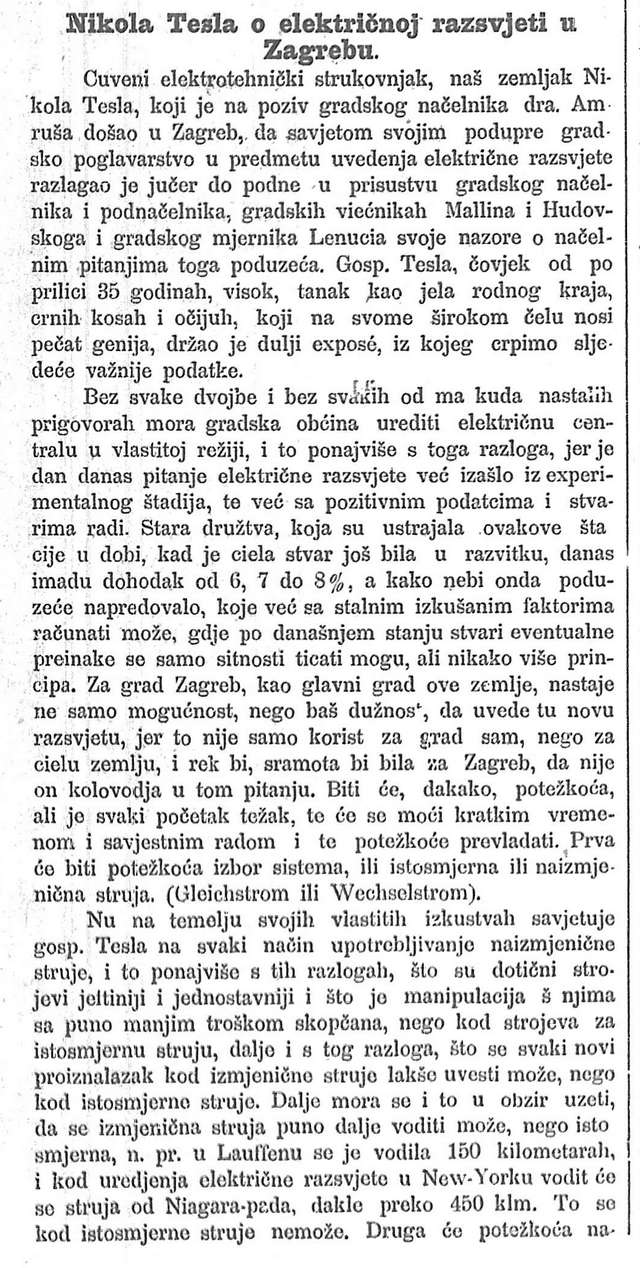
Many thanks to the National and University Library in Zagreb for Narodne novine (People's News) of May 25th, 1892, where this little known and very important article was published.
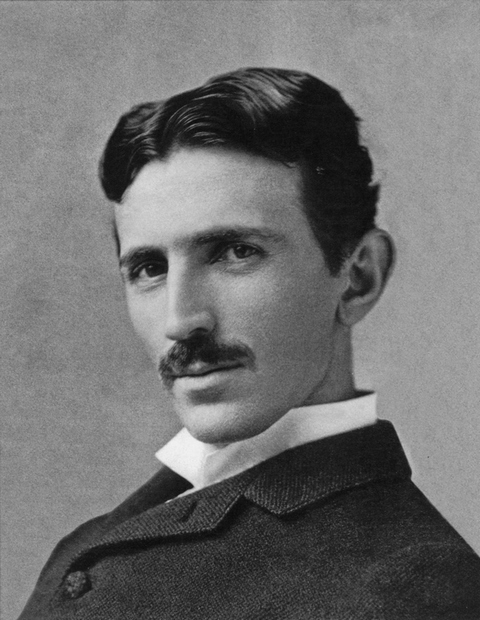
Photo by Napoleon Sarony, distinguished American portrait photographer.
Nikola Tesla on electric lighting in Zagreb
A famous electrical engineering expert, our compatriot Nikola Tesla, who at the invitation of the mayor dr. Amruš arrived to the city of Zagreb, in order to support the city officials in matters dealing with introducing electrical lighting, expounded his views in presence of the city mayor and vice mayor, city councilors Mallin and Hudowski, and the city surveyor Lenuci, dealing with essential questions of the enterprise. Mr. Tesla, a man at the age of about 35, tall, slim as a fir of his homeland, of black hair and eyes, who on his broad forehead bears a mark of a genius, had a longer exposé, from which we draw the following more important information....
He will, on the other hand, examine the offers which will arrive to the city authorities, and will provide his opinion about them, so that any possible misuse could be prevented. And in general, he considers his duty to help the administration of the city in any respect with his advice and action, as a native son of this land, and asks the city to contact him in any occasion in which technical difficulties might arrive, and he will provide his advice without any recompensation, the best he could. -
With this, he ended his interesting analysis. The city mayor, Dr. Amruš, expressed the heartiest gratitude for his efforts and for his promise, wishing him the best success in his future work, which was flattering in front of the world not only for him, but also for his homeland. In the discussion that followed, Mr. Tesla mentioned that now he works on the realization of the hypothesis, which he thinks is realizable and of profound importance, namely the wireless transfer of electric current by means of the natural electricity of the Earth. We wish success to our compatriot from the bottom of our heart in his endeavors. ...
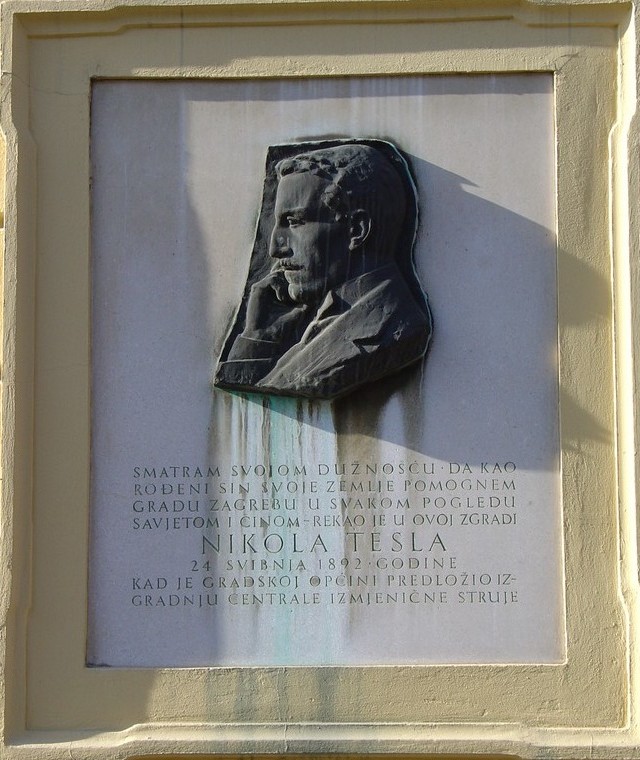
to help the city of Zagreb with advice and action in every respect.
Words pronounced in the City Hall, on May 24th, 1892, when he suggested the City Council building an AC power plant. Setting this plaque, created by academic sculptor Grga Antunac, has been incited by professor Vladimir Muljević.
Electric plant (Munjara) of the city of Karlovac in 1908 in Ozalj
munjara = electric plant (derived from munja - lightning)
In 1908, a hydro plant, i.e., munjara, was built in the town of Ozalj (near the city of Karlovac), on the basis of the alternating current (AC) technology of Nikola Tesla. The building was designed by distinguished architect Hermann Bolle (1845-1925), better known as the designer of the Zagreb Cathedral, the Mirogoj Cemetery, etc. The first hydro plant in Croatia was built near the city of Šibenik already in 1895 (on the Krka river, now a National Park of Croatia), as one of the oldest AC electric plants in the world.
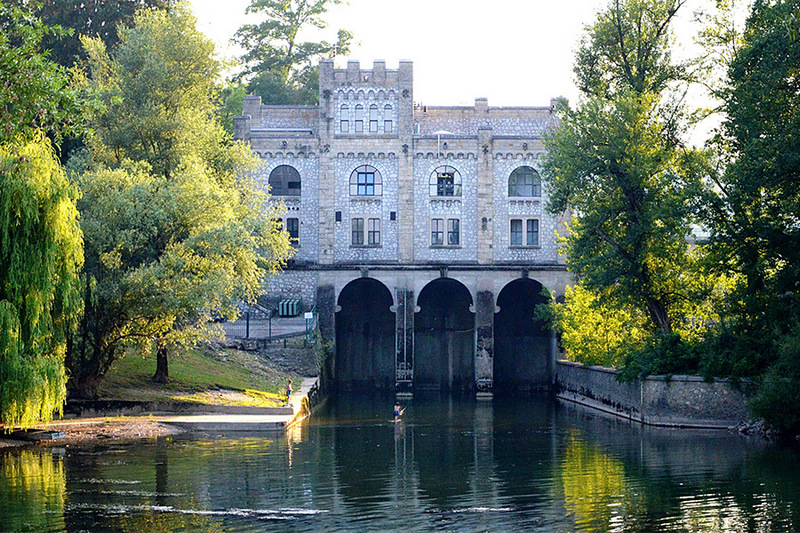
Source of the photo: Tourist Association Ozalj.
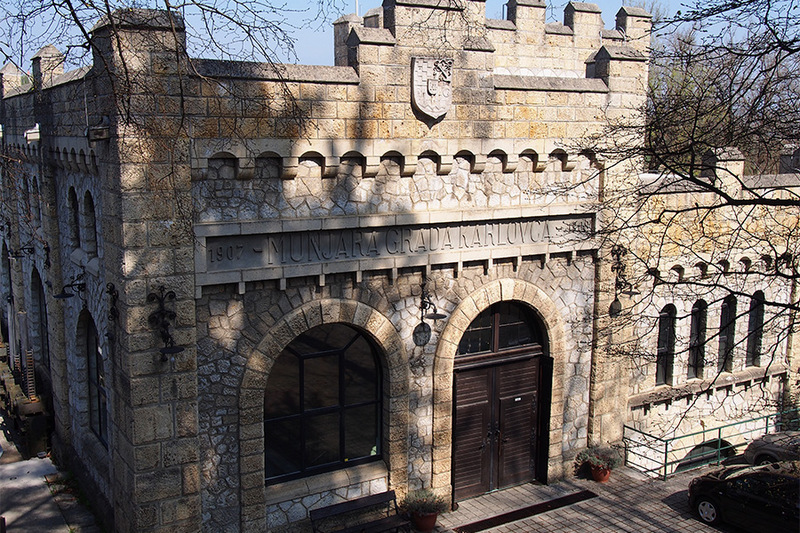
as a part of the Coat of Arms of Karlovac.
The city of Gospić had its first electric plant in 1925 (see HEP). Tesla's birthplace, the village of Smiljan, obtained AC current as late as 1956, i.e., 100 years after his birth.
The city of Zagreb built its first Munjara (electric plant) in 1907, in the region Trešnjevka, very near Panorama Hotel (on the south of it). The street where Munjara was built is even today called Munjarski put (Electric plant lane).
On August 26th, 1895, the first hydroelectric plant was launched on the Niagara Falls. Only two days later, the first Croatian hydroelectric AC plant plant was launched on the Krka Falls (Krka National Park in Croatia), which on August 28th, 1895 lighted the city of Šibenik.
Here is a list of AC electric plants built in various Croatian cities and towns, in chronological order:
- Šibenik 1895
- Zadar 1895
- Opatija 1896
- Rijeka 1897
- Sušak 1900
- Dubrovnik 1901
- Rab 1902
- Varaždin 1905
- Daruvar 1907 (half a year before Zagreb)
- Zagreb 1907
- Karlovac 1908
- Vukovar 1909
- Mali i Veliki Lošinj 1910
- Petrinja 1911
- Topusko 1911
- Munjara Našice 1910
- Slavonska Požega 1912
- Đakovo 1915
- Sisak 1915 (industrial electric plant)
- Split 1920
- Korčula 1922
- Čakovec 1922
- Sinj 1923
- Cres 1924
- Hvar 1925
- Omišalj 1925
- Koprivnica 1925
- Prelog 1925
- Krapina 1926
- Slavonski Brod 1927
- Crikvenica i Selca 1927
- Senj 1928
- Zlatar 1928
- Lepoglava 1928
- Bakar 1929
- Krk 1929
- Punat 1929 (projected directly by Nikola Tesla!)
- Gospić 1929
- Perušić 1929
- Vinkovci 1929
- Baška 1930
- Makarska 1930
- Baška 1930
- Makarska 1930
- Otočac 1930
- Vis 1931
- Novi Vinodolski 1932
- Lipik 1932.
- Hrvatska Kostajnica 1934
- ...
- Smiljan (the birthplace of Nikola Tesla) 1956 (in fact, in 1958; see a few lines below)
The above claim that the village of Smiljan obtained electric current in 1956 should be corrected to 1958. See the monograph [Tomljenović, Smiljan i okolica].
On the territory of Smiljan (the birthplace of Nikole Tesle in the region of Lika), there are proof of literacy in Croatian Glagolitic Script already since the 15th century; more precisely, since 1445. Fra Petar Runje, honorary member of the Society of the Friends of the Glagolitic Script in Zagreb, mentions a document from 1504 confirming this. He also mentions an evidence for the existence of glagolitic priests in the environs of Smiljan from 1732. All this is described by Ana Tomljenović (1938-2023) on p. 131 of her excellent monograph [Smiljan i okolica] (Smiljan and Its Environs) published in 2003. The book was prepared with professional help of distinguished Croatian experts: prof. dr. Ante Bežen, bishop dr. Mile Bogović (honorary memeber of the Society of the Friends of the Glagolitic Script), dr. Željko Holjevac i prof. dr. Dane Pejnović).
Personal acquaintances of Nikola Tesla
Some of the personal friends of Nikola Tesla (there are no known joint photos with Tesla, except for Fritzie Zivic, Croatian-American boxer):
- Milka Trnina (or Ternina, 1863-1941), soprano singer, the greatest Croatian opera singer in history, born in the region of Moslavina near Croatia's capital Zagreb; because of her, Tesla booked a loggia in Metropolitan Opera in New York, where Ternina had as many as 79 appearances; she sang at one of his birthday parties; according to the opinion of [Mario Filipi, Tesla did not meet with Baloković.
- Ivan Meštrović (1883-1962), distinguished Croatian sculptor;
- Zlatko Baloković (1895-1965), distinguished Croatian violinist, played at Tesla's funeral in 1943; according to the opinion of [Mario Filipi, Tesla did not meet with Baloković.
- Marijan Matijević (1878-1951, financially supported Tesla in the 1920s), in his time the strongest man in the world. His help to Tesla is mentioned by George Juraj Prpić in his monograph Croatians in America (there is a Croatian translation - Hrvati u Americi), of the Lika descent, born in Banat, university professor in the USA (John Carrol University, Department of History, Cleveland);
- Ivan (John) Benković (1886-1918), was born in the village of Rečica near the city of Karlovac and studied painting at the Academy of Arts in Zagreb. He arrived in the USA in 1912, working as commercial artist in New York, under the pseudonym Bankow. He made a live portrait of Nikola Tesla in 1913 (one of only two Tesla's live portraits). With his recommendation letter, Tesla helped him to get employment in respectable Catholic journal entitled Extension Magazine, as well as in Hrvatski Svijet (Croatian World). He died prematurely out of the Spanish flew. See [Vladimir Novak, Croatians in America, p. 73]. The mentioned Tesla's portrait, drawn by Ivan Benković, is kept in the Museum of N. Tesla in Belgrade, while Tesla's recommendation letter is in the City Museum in Samobor near Zagreb.
- Fritzie Zivic (1913.-1984.), American boxer of Croatian roots, welterweight world champion in 1940 and 1941. His father Živčić was born in the Croatian town of Bosiljevo.
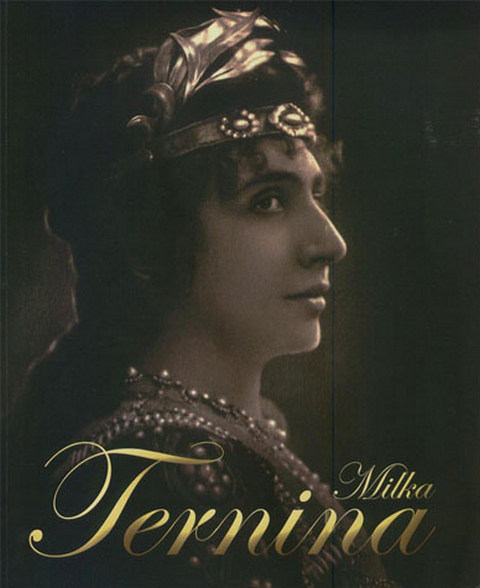
source of the photo Museum of the City of Zagreb
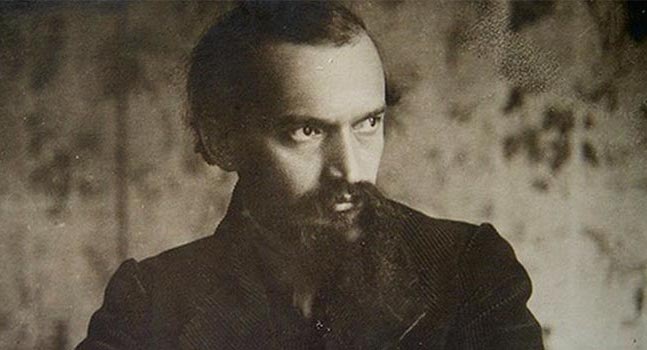
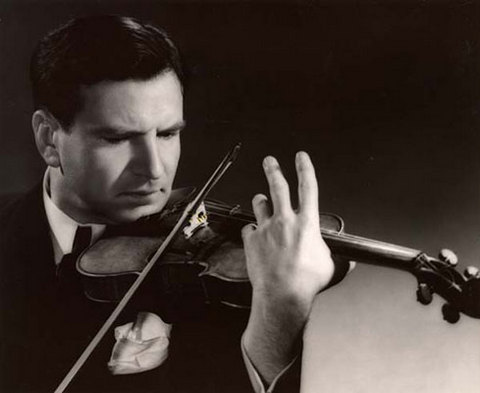
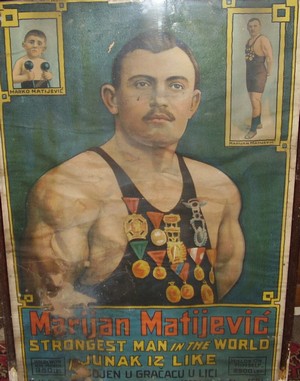
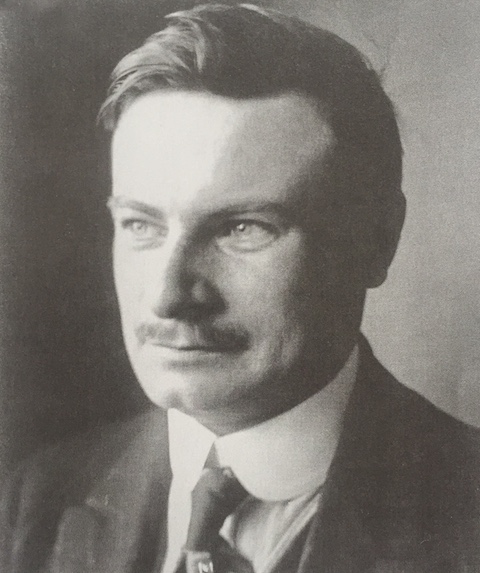
Source [Vladimir Novak, Croatians in America, p. 73]. Benković and Tesla attended the secondary school in the same building in the city of Karlovac.

Our gratitude goes to Mrs. Milica Kesler of the Museum Nikola Tesla in Belgrade, for having sent us the photo.
Dimensions of the portrait are 76 x 63 cm (by the courtesy of Mrs. Jasenka Ferber Bogdan, HAZU).
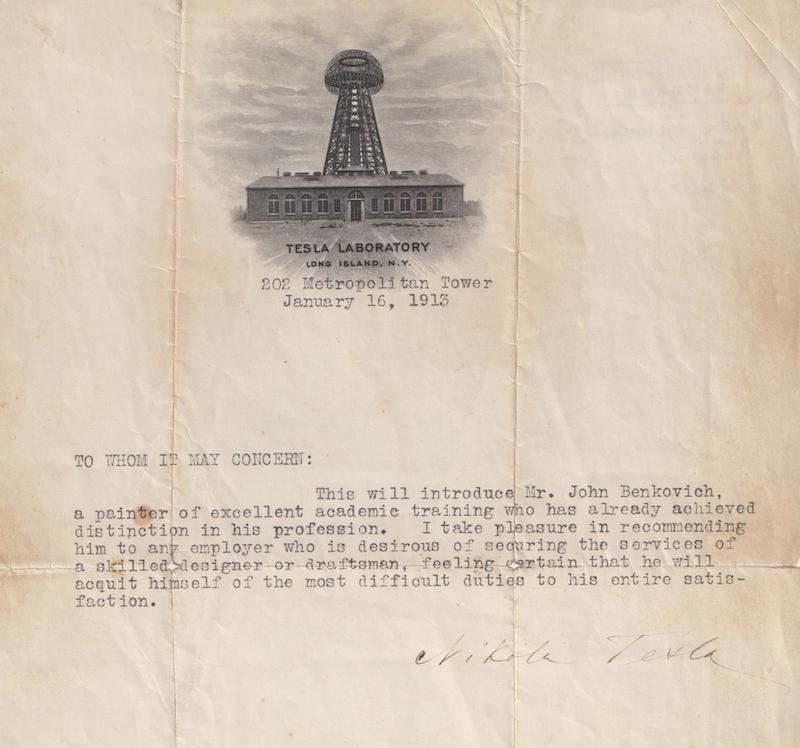
Many thanks to the Samobor Museum for having sent us the photo.
TESLA LABORATORY
LONG ISLAND, N. Y. 202 Metropolitan Tower
January 16, 1913
TO WHOM IT MAY CONCERN:
This will introduce Mr. John Benkovich,
a painter of excellent academic training who has already achieved
distinction in his profession. I take pleasure in recommending
him to any employer who is desirous of securing the services of
a skillful designer or draftsman, feeling certain that he will
acquit himself of the most difficult duties in his entire satis-
faction.
Nikola Tesla
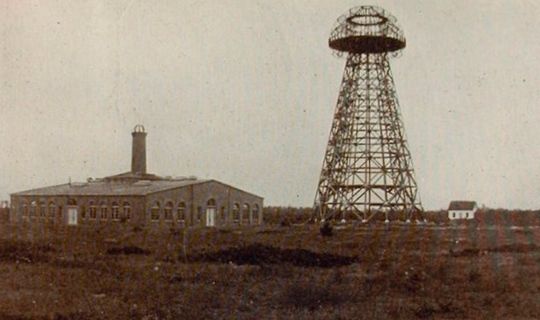
Height 57 m, diameter of the cupola 17 m. Financed by J. Pierpont Morgan.
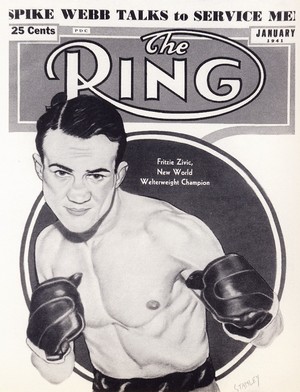
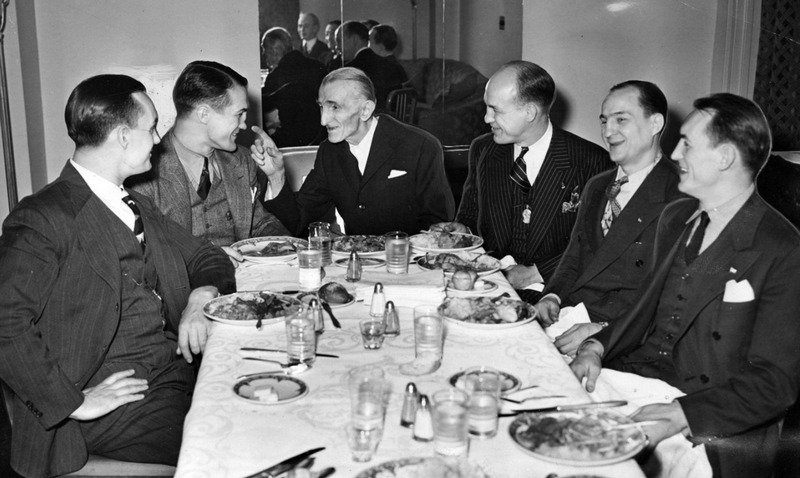
There are at least two more persons at the table, noticeable in the mirror behind Tesla.
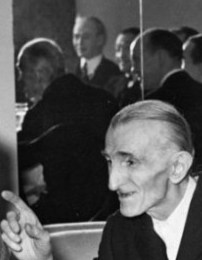
Scott wrote a very nice article, published in Zagreb in 1929, describing Tesla's work on the
development of his polyphase system.
On the right of Scott in mirror could be Fiorello La Guardia, the then mayor of New York. This conjecture was first mentioned by D.Ž. during the PIFT (Povijest i filozofija tehnike - History and Philosophy of Technique) conference organized in October 2020 in Zagreb, during his lecture about Scott and Tesla.
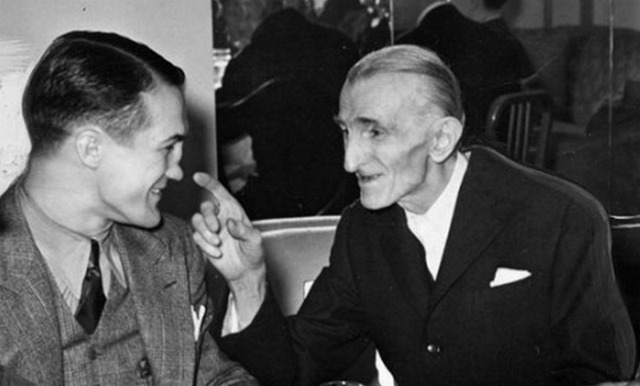
This is of the rare photos where Tesla smiles (many thanks to Mr. Mario Filipi for his remark).
This very nice and amusing photo has been shot in 1941, just two years before Tesla's death.

Prior to 1880, Tesla got acquainted with great Czech composers Smetana and Dvoržak, that he was later meeting in Metropolitan Opera in New York; see [Petešić, p. 40].
Bust of Nikola Tesla within the Faculty of Electrical Engineering and Computing (of the University of Zagreb) and in the Technical Museum in Zagreb was carved in 1930s by Emil Bohutinsky, Croatian sculptor born in Križevci near Zagreb.
Ferdinand Kovačević (Smiljan 1838-Zagreb 1913), patented duplex
connection for telephone transmission, which enabled sending Morse code
through a single wire in both directions simultaneously. It was patented
in 1876 in Vienna. Kovačević was born in the village of Smiljan, as
well as Tesla. 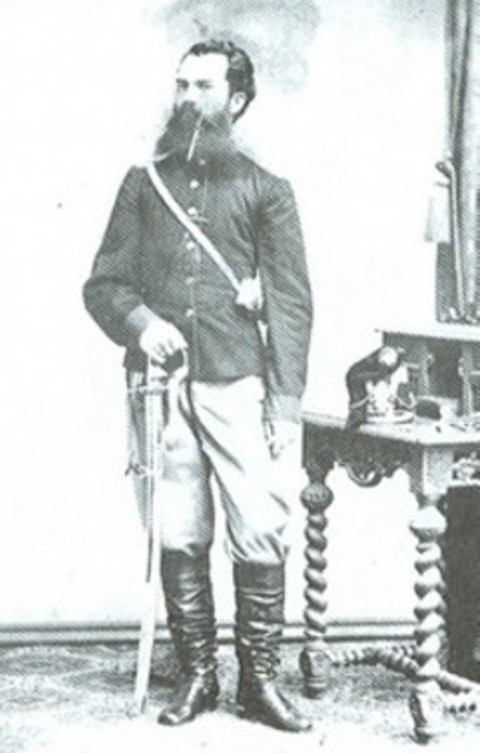
Photo from genius-croatia.
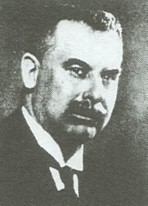


He patented it with Alexander Just from Austria.
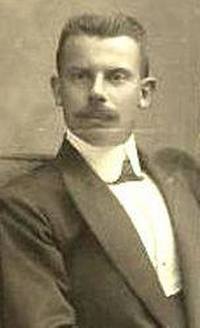
born in the village of Drinovci near Županja, Croatia.
According to Josip Moser (president of the Electrotechnical Society Zagreb), a prestigious Austrian society called Elektrotechnischer Verein, among its 181 founding members in 1886 in Vienna, as many as 40 of them were from Croatia. We mention for example
- Ferdianand Kovačević (inventor of the duplex connection; born in the village Smiljan, as Tesla)
- Martin Sekulić (Tesla's professor of Physics)
- Nikola Tesla
- Vinko Dvoržak (born in Bohemia, earned his PhD under the guidance of Ernst Mach at the Charles University in Prague; founder of the study of Physics at the University of Zagreb, Croatia)
- Oton Kučera (popularizer of science as well as of Tesla's AC technology; born in Petrinja near Zagreb).
Fiorello LaGuardia, Nikola Tesla and Croatian language
Tesla's Eulogy given by Mayor Fiorello LaGuardia in 1943, New York.Fiorello LaGuardia (1882-1947) was American consular agent in the city of Rijeka (1903-1906). According to personal information by Mr. Vladimir Novak, he liked to sing Croatian songs, and when he arrived in the USA, he was employed at the Ellis Island in New York (1907-1910), where he accepted immigrants from Croatian lands. See [Vladimir Novak, Croatians in America, p. 71]. He was the most successful mayor of New York in history (from 1934 to 1945). A New York airport is named LaGuardia Airport after him.
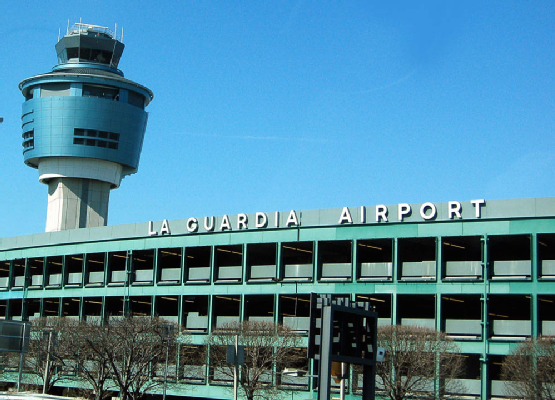
Fiorello H. LaGuardia, who would later become one of America's foremost public servants, was an interpreter on Ellis Island from 1907 to 1910. Certified to speak three languages - Italian, German, and Croatian, LaGuardia received an annual salary of $1,200.He was also fluent in Yiddish (source: Fiorello La Guardia: Ultimate American, and in particular this photo):
La Guardia utilized his knowledge of several languages, reportedly including Hebrew: Croatian, German, Italian, and Yiddish.
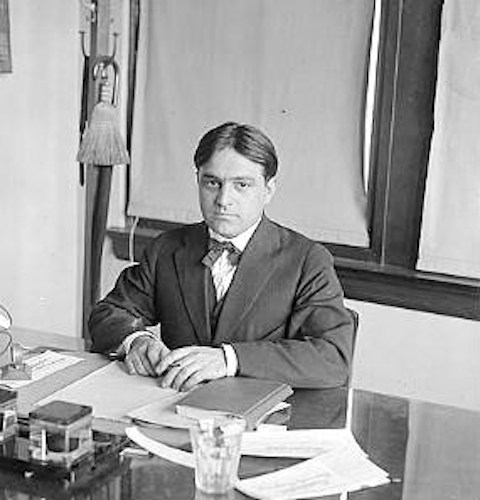
where he accepted immigrants to the USA. The photo is from about 1910. Source: Fiorello La Guardia: Ultimate American.
Mr. Chester did me a good turn by sending me to Croatia one summer for four months for the express purpose of studying Croatian.LaGuardia's grandfather Abraham Isaac Coen was born in 1833 in the city of Split, as a member of the Jewish community in this city, which has existed there for centuries. See [Vladimir Novak, Croatians in America, p. 71].
Croatian was tough, with its seven cases, all of them used, and its many conjugations of verbs.
While I never pretended to be expert in this language, I did learn enough of it to pass a Civil Service examination later, which enabled me to get the job as interpreter at Ellis Island that helped me work my way through law school.
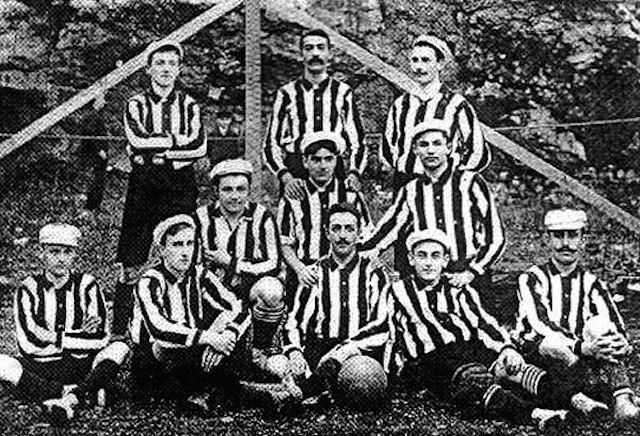
Young Fiorello
La Guardia (1882-1947) played soccer in the city of Rijeka
(Fiume) in 1905,
then at the age of 23,
here in the middle of the second line. The soccer club was a part of
the Club Atletico Fiumano,
and La Guardia served as American consul in Rijeka in 1904-1906. He was
the greatest mayor in the history of New York.

Fiorello La Guardia learned Croatian language
in these years.
Source of the photo: www.formula1-dictionary.net/rijeka_povijest_1900-1925.html
Tesla's predictions of Internet and mobile phone
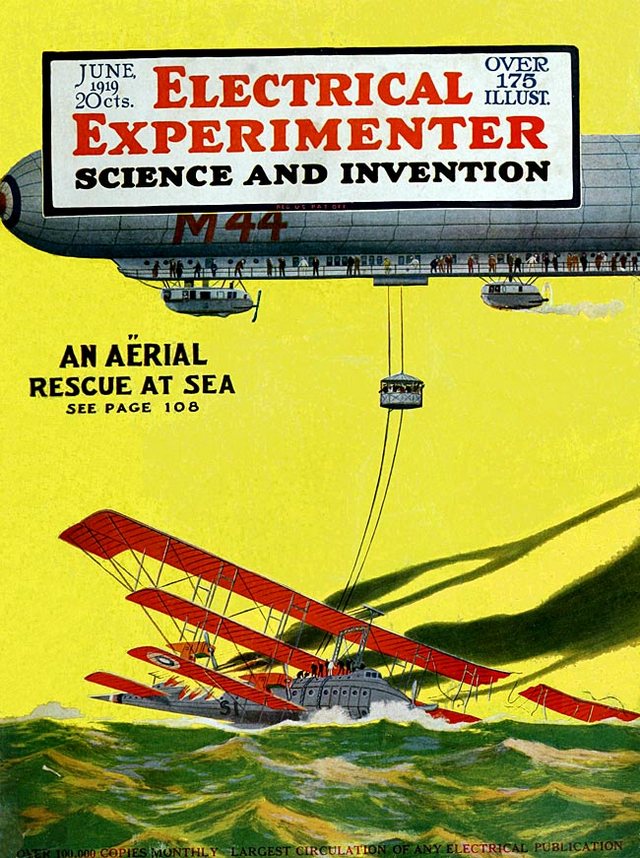
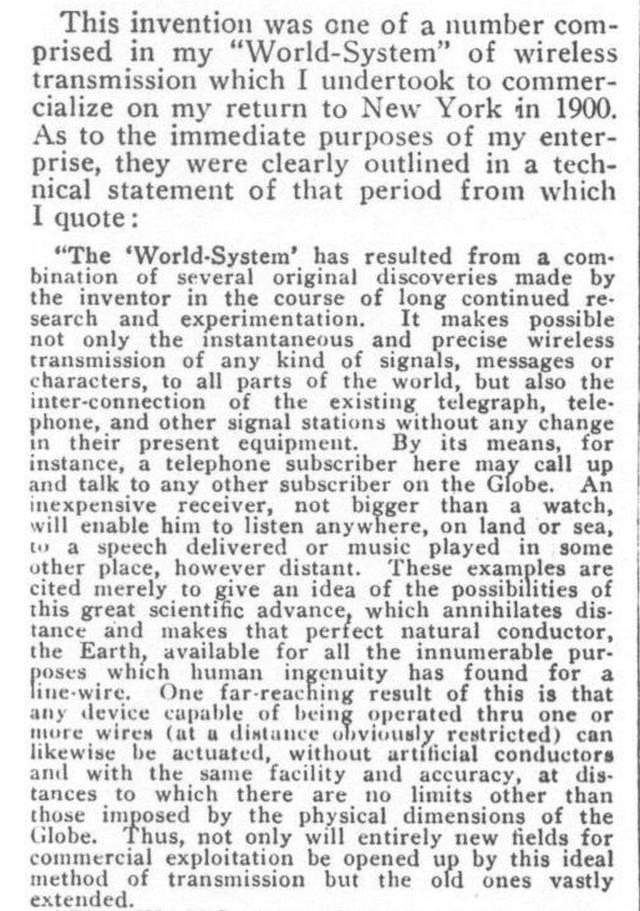
Nikola Tesla in his autobiography My Inventions, published by Electrical Experimenter in 1919, in the fifth part of his series (entitled The Magnifying Transmitter), for the first time announces to the broad public his prediction of the advent of mobile phones, and even of the Internet:
This invention was one of a number comprised in my "World-System" of wireless transmission which I undertook to commercialize on my return to New York in 1900. As to the immediate purposes of my enterprise, they were clearly outlined in a technical statement of that period from which I quote:
"The 'World-System' has resulted from a combination of several original discoveries made by the inventor in the course of long continued research and experimentation. It makes possible not only the instantaneous and precise wireless transmission of any kind of signals, messages or characters, to all parts of the world, but also the inter-connection of the existing telegraph, telephone, and other signal stations without any change in their present equipment. By its means, for instance, a telephone subscriber here may call up and talk to any other subscriber on the Globe. An inexpensive receiver, not bigger than a watch, will enable him to listen anywhere, on land or sea, to a speech delivered or music played in some other place, however distant. These examples are cited merely to give an idea of the possibilities of this great scientific advance, which annihilates distance and makes that perfect natural conductor, the Earth, available for all the innumerable purposes which human ingenuity has found for a line-wire. One far-reaching result of this is that any device capable of being operated thru one or more wires (at a distance obviously restricted) can likewise be actuated, without artificial conductors and with the same facility and accuracy, at distances to which there are no limits other than those imposed by the physical dimensions of the Globe. Thus, not only will entirely new fields for commercial exploitation be opened up by this ideal method of transmission but the old ones vastly extended. ...
Colliers journal of January 30th, 1926, published in an interview of John B. Kennedy with Nikola Tesla, under the intriguing title When woman is a boss, in which Tesla predicts very explicitly the advent of what we call today Internet and mobile phones.
When wireless is perfectly applied the whole earth will be converted into a huge brain, which in fact it is, all things being particles of a real and rhythmic whole. We shall be able to communicate with one another instantly, irrespective of distance. Not only this, but through television and telephony we shall see and hear one another as perfectly as though we were face to face, despite intervening distances of thousands of miles; and the instruments through which we shall be able to do his will be amazingly simple compared with our present telephone. A man will be able to carry one in his vest pocket.Let us not forget that Tesla announces his visionary prediction in the period of the deaf film, which lasts until the end of 1920s!
We shall be able to witness and hear events - the inauguration of a President, the playing of a world series game, the havoc of an earthquake or the terror of a battle - just as though we were present.
In 1882, Nikola Tesla discovered the principle of rotating electromagnetic field and of the induction motor in Budapest. Two years later, in 1884, he leaves for the USA. In the course of 1887-1890, Tesla patented his key inventions in the field of low frequency alternating currents. After that he passes to the study of high frequency technique.
The overall number of Tesla's patents is 112. With subpatents, improvements, and variations, this number is much larger, above 600.
Outside of the USA, Tesla protected 109 of his patents in 24 countries. Here is the list of countries in alphabetic order, where we placed the first year of protection of his patent in a respective country, as well as the overall number of protected Tesla's patents (see Catalogue):
- Argentina, 1912, 2
- Australia, 1896, 3
- Austria, 1901, 3
- Belgium, 1891, 11
- Brasil, 1901, 3
- Canada, 1912, 1
- Cuba, 1901, 1
- France, 1891, 13
- Germany, 1895, 14
- Great Britain, 1891, 16
- Hungary, 1898, 7
- India, 1894, 2
- Italy, 1894, 10
- Japan, 1912, 1
- Mexico, 1910, 1
- New South Wales, 1897, 2
- New Zealand, 1910, 1
- Norway, 1901, 2
- Rhodesia, 1910, 1
- Russia, 1900, 4
- Spain, 1899, 4
- Switzerland, 1900, 4
- Sweden, 1900, 1
- Transvaal, 1910, 1
As we can see, Tesla had the largest number of his protected patents in Great Britain, Germany, France, Belgium, and in Italy.
Acknowledgements: Gymnasium in Karlovac (in particular to Sanda Furjanić and Antun Milinković), Croatian School Museum in Zagreb, Vladimir Muljević, Vatroslav Lopašić, Nikola Piasevoli, Zvonko Benčić, Željko Hanjš, Marijan Ožanić, Željko Krnjak, Dina Šimunić, Ivica Pavić, Milica Kesler, Jasenka Ferber Bogdan, Robert Bulat.
Literature
- Nikola Tesla: My Inventions (on the left page, on the left of the photo of induction motor, there is a description of his ingenious professor of Physics from Karlovac (Martin Sekulić)
- Vladimir Muljević: Martin Sekulić (1833-1905), Elektrotehnika br. 5, 1973, pp. 331-338.
- Ćiril Petešić: Genij s našeg kamenjara / Život i djelo Nikole Tesle (2. izdanje), Školske novine, Zagreb, 1977. (the booklet had 7 editions, and the first one was printed in 10.000 copies; information by the courtesy of professor Ante Bežen)
- Leo Randić (ed.): Pola stoljeća od boravka nobelovca Maxa Plancka u Zagrebu (Half a century since a stay of Max Planck in Zagreb), Priroda 3-4-5 (1992.), pp. 8-9 (the article contains a contribution by Dušan Pejnović from 1942: Predavanje Maxa Plancka u Zagrebu 15. rujna 1942. (A lecture by Max Planck in Zagreb, delivered in 1942), from the daily press of NDH preserved by Tihomir Šurina)
- Rudolf Strohal: Grad Karlovac opisan i orisan (The city of Karlovac described and Painted), Karlovac 1906. (Strohal was a director of Gymnasium in Karlovac, in the same building where there used to be situated the Higher Real School attended by Nikola Tesla during his secondary schooling from 1870-1873.)
- Antun Cuvaj: Građa za povijest školstva kraljevina Hrvatske i Slavonije od najstarijih vremena do danas VI., Zagreb, 1911., rakovačka Velika realka je opisana na str. 212-218.
- Natalija Jadrić i Tanja Mihaljević: Nikola Tesla - školovanje u Karlovcu [PPT]
- Boris Markovčić, Ivan Prpić, Franjo Plic, Ante Busatto: Razvoj elektrifikacije Hrvatske, 1. dio, od početaka elektrifikacije do 1945. g., Institut za elektroprivredu, Zagreb 1984.
- Darko Žubrinić:
- Školovanje Nikole Tesle u Hrvatskoj i njegov profesor Martin Sekulić [PDF] (sažetak), u Povijest i filozofija tehnike / radovi EDZ sekcije 2017. godine / Benčić, Zvonko ; Moser, Josip (ur.). Zagreb : Kiklos, 2017. Str. 81-117.
- Nastava hrvatskog jezika, matematike i fizike tijekom školovanja Nikole Tesle u Hrvatskoj [PDF], u Povijest i filozofija tehnike / radovi EDZ sekcije 2018 godine / Benčić, Zvonko (ur.). Zagreb : Kiklos, 2018. Str. 293-317
- Nikola Tesla 1856.-1943., istaknuti hrvatsko-američki znanstvenik
- Ivica Vuković i Anđa Valent: Autori matematičkih rasprava u izvješćima rakovačke realke [PDF], PRIRODOSLOVLJE 16(1-2) III (2016), str. 89-110 (osobito str. 104-110)
- Kraljevska viša realna škola u Rakovcu; vidi također FOND
- Vladimir Paar: Fizičar Nikola Tesla, 1. dio, 2. dio, 3. dio
- Vladimir Novak: Croatians in America, Zagreb - Croatia, 2018, ISBN 978-953-7616-06-09
- Vladimir Muljević: Elektrotehnika / Kronologija razvitka u Hrvatskoj (Chrnology of development of Electrical Engineering in Croatia), Zagreb 1999.
- Dušan Pejnović:
O školovanju Nikole Tesle u Rakovcu (izvornik [JPG]), Matematičko-fizički list, Zagreb, br. 3, 1956-57, str. 112
Dušan Pejnović (1883-1958) was Croatian physicist, assistent of Professor Stanko Hondl, author of about 160 papers (information by Dr. Branko Hanžek) and a collaborator of Croatian Encyclopedia. - Katalog Teslinih patenata / Catalogue of Tesla's patents, Beograd 1987.
- Ana Tomljenović: Smiljan i okolica (Brušane, Trnovac, Bužim), Meridijani, Samobor 2003. (recenzenti Ante Bežen, Mile Bogović, Željko Holjevac, Dane Pejnović)
- Tesla's assitant Charles F. Scott
- Nikola Tesla Network
- Darko Žubrinić: Duhovnost Nikole Tesle
- Mario Filipi: Nikola Tesla ispod paučine (third edition), Zminjak Samobor, 2022.